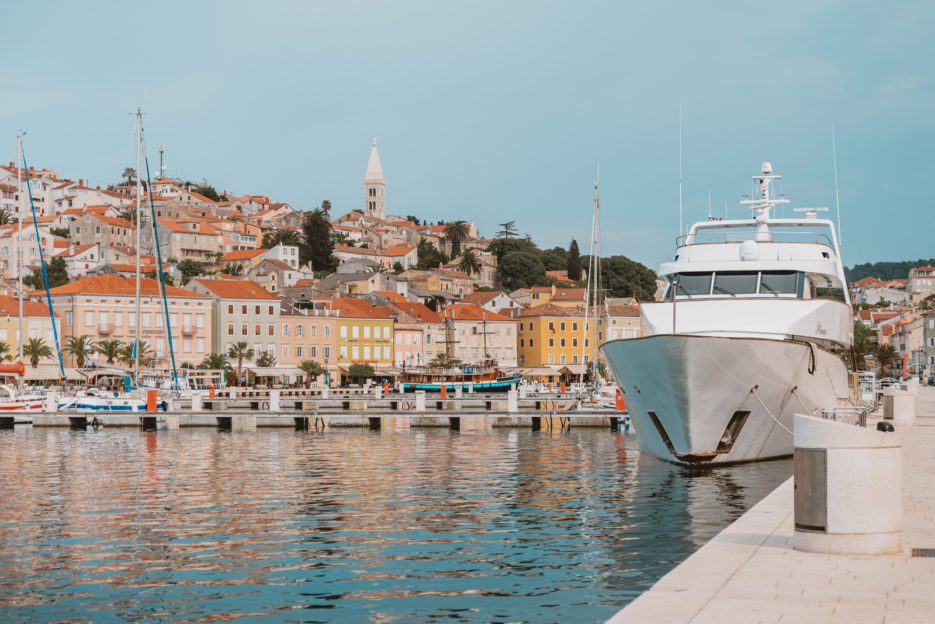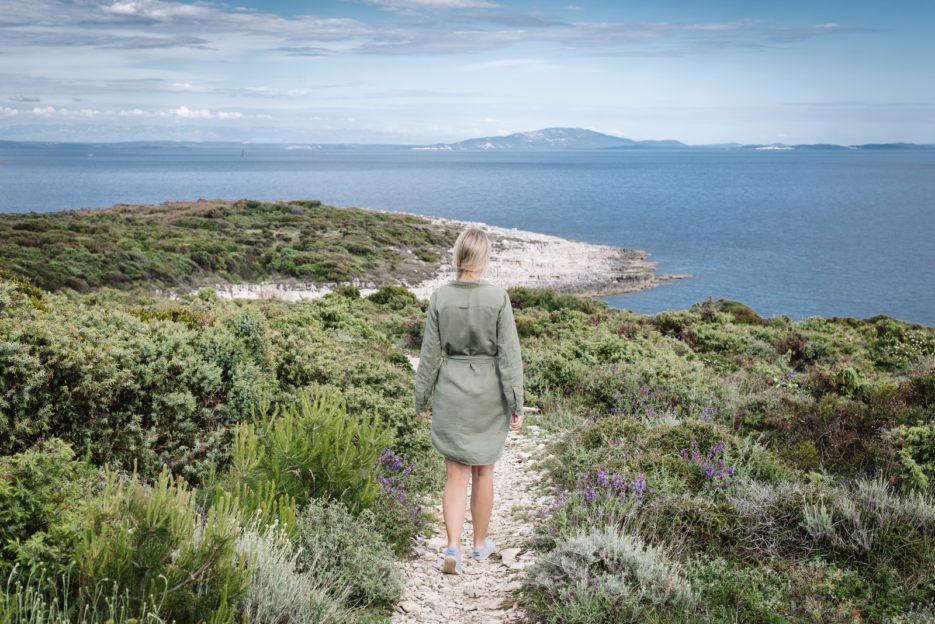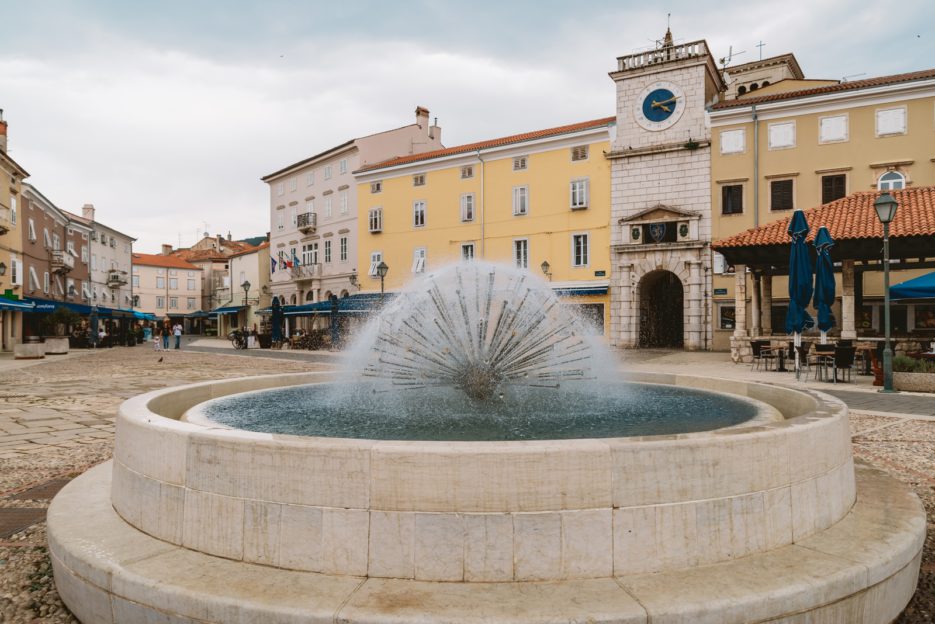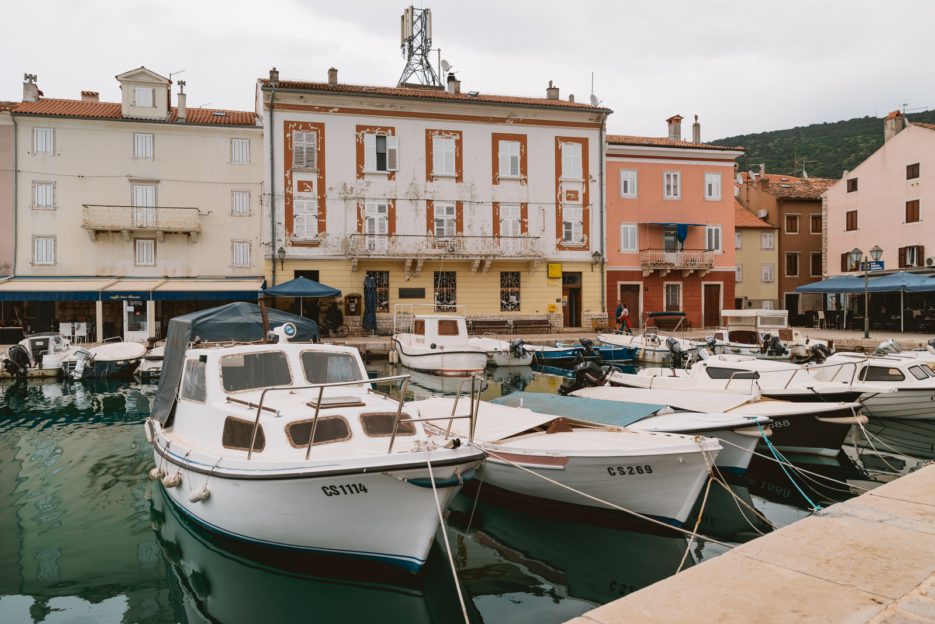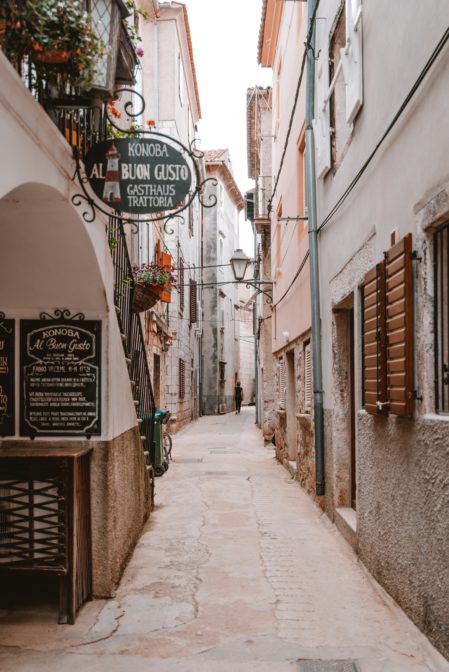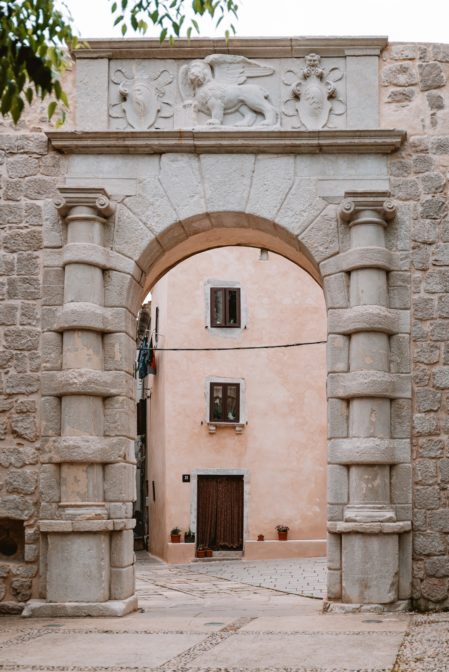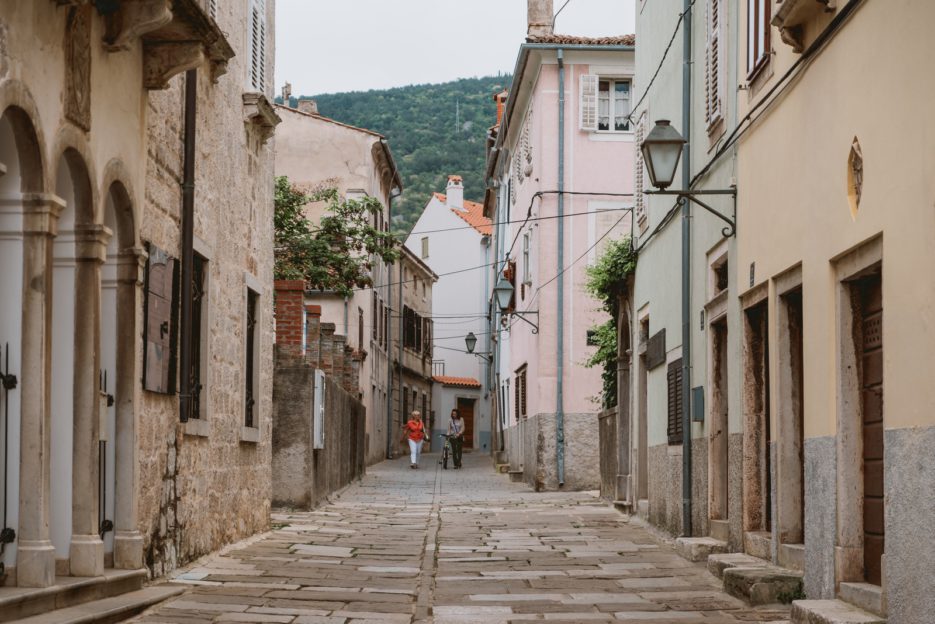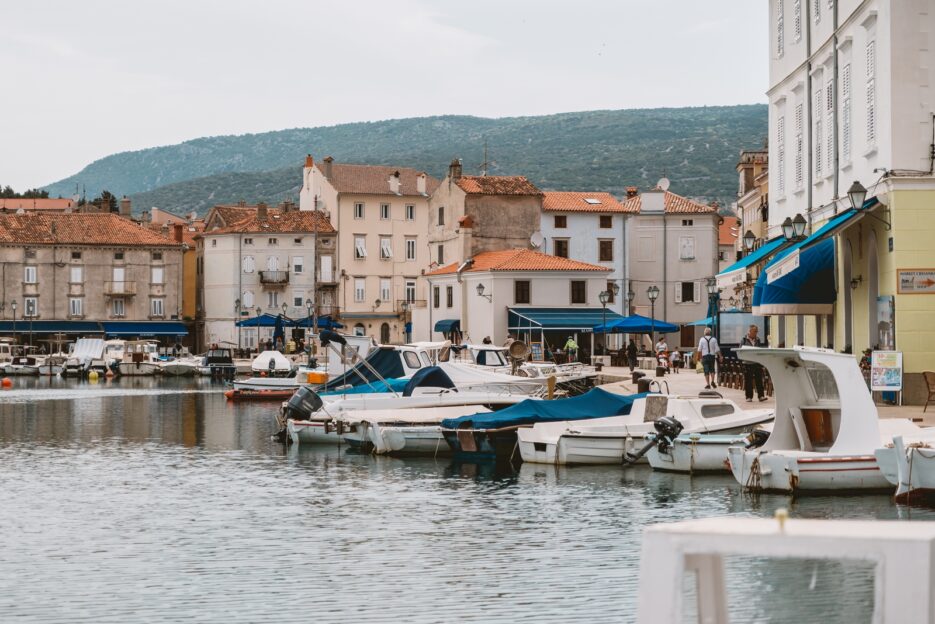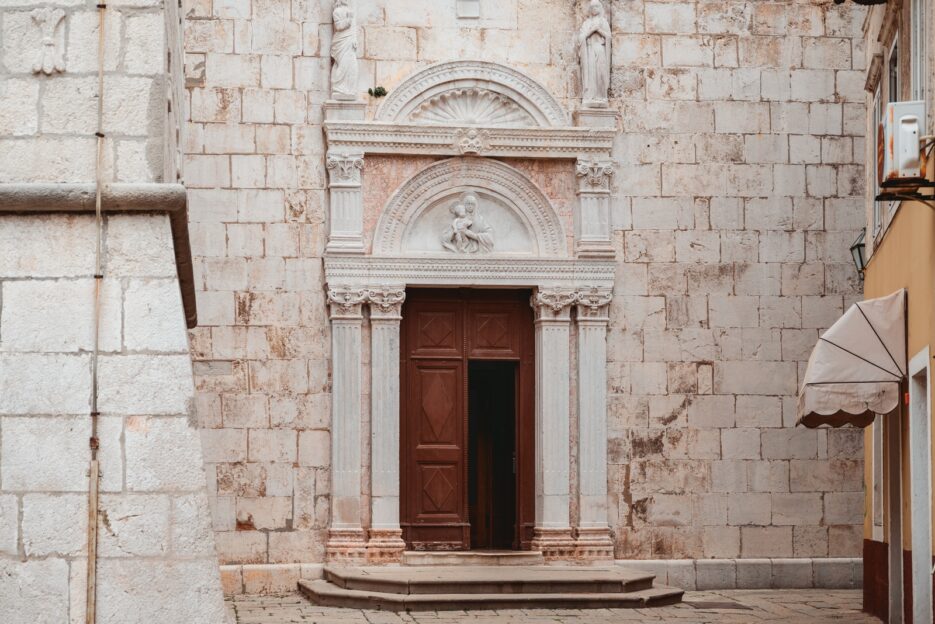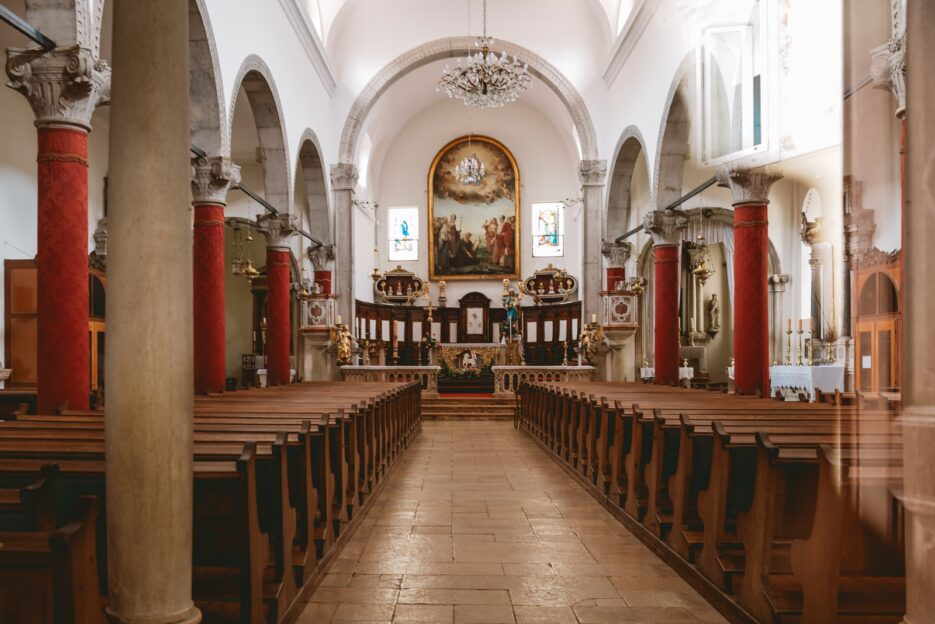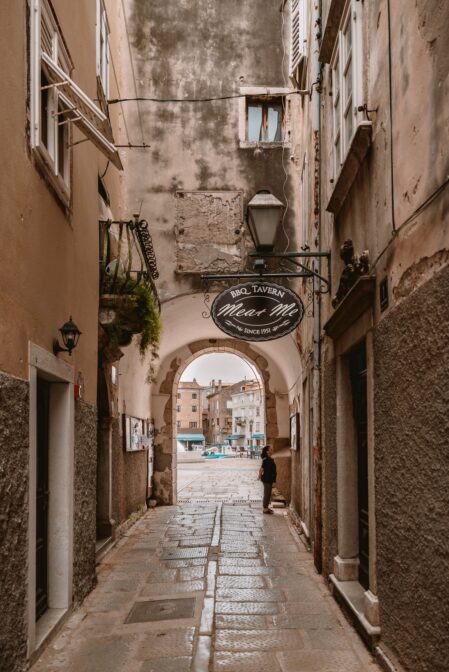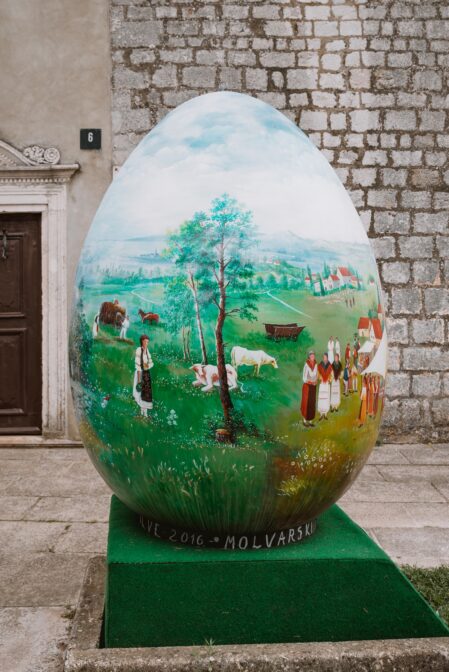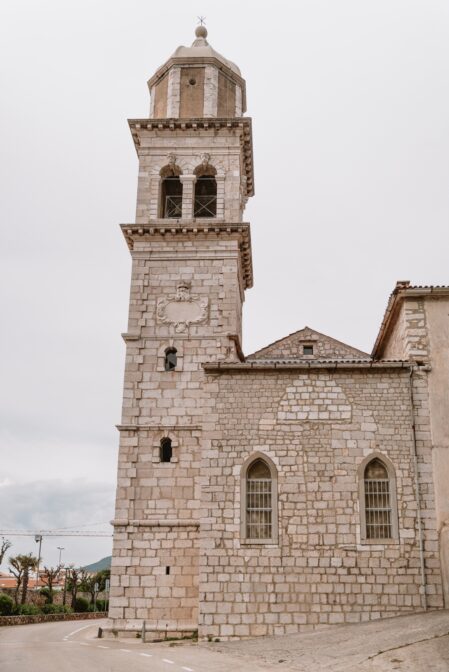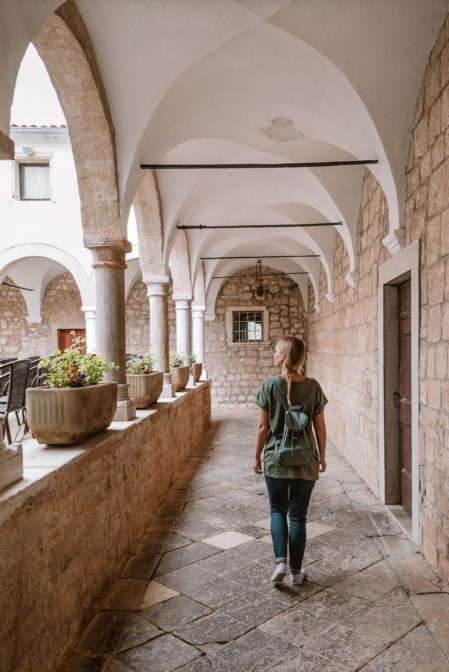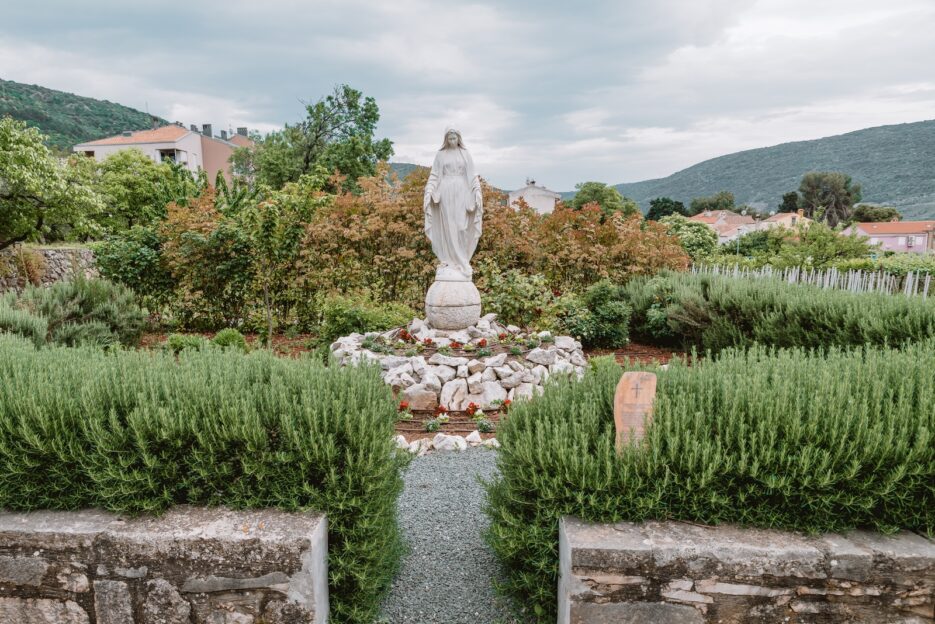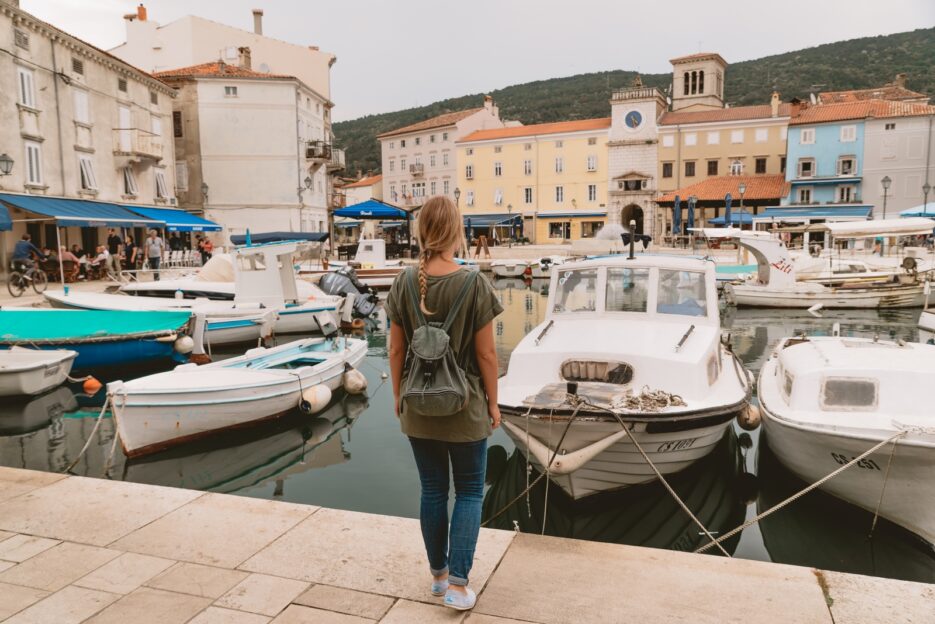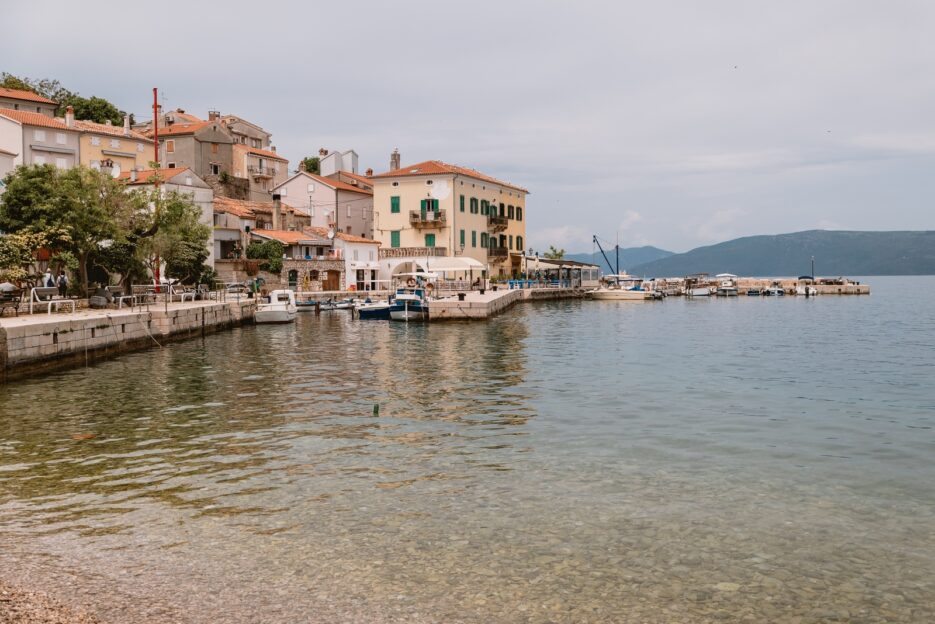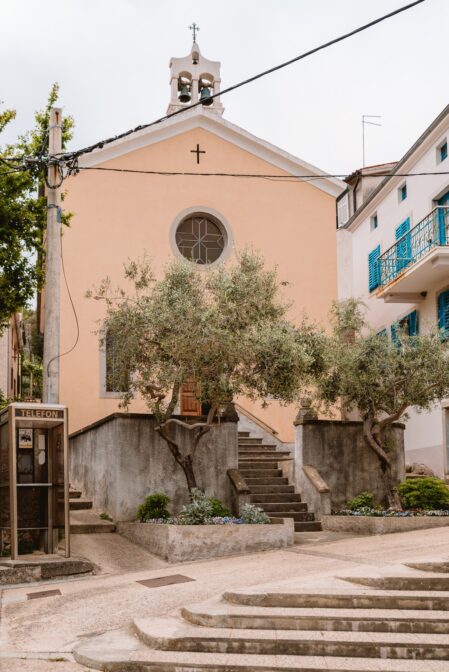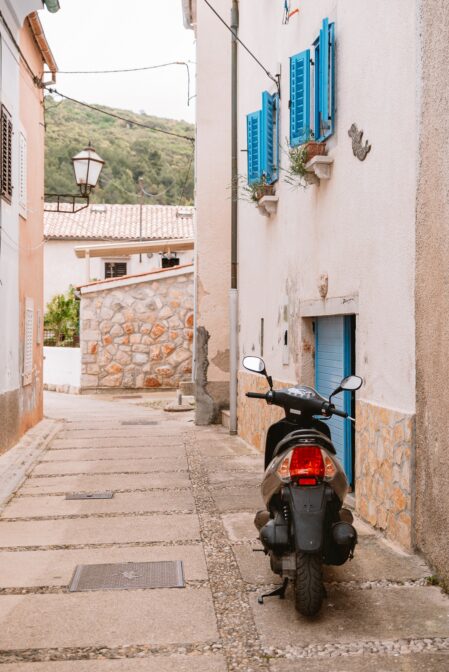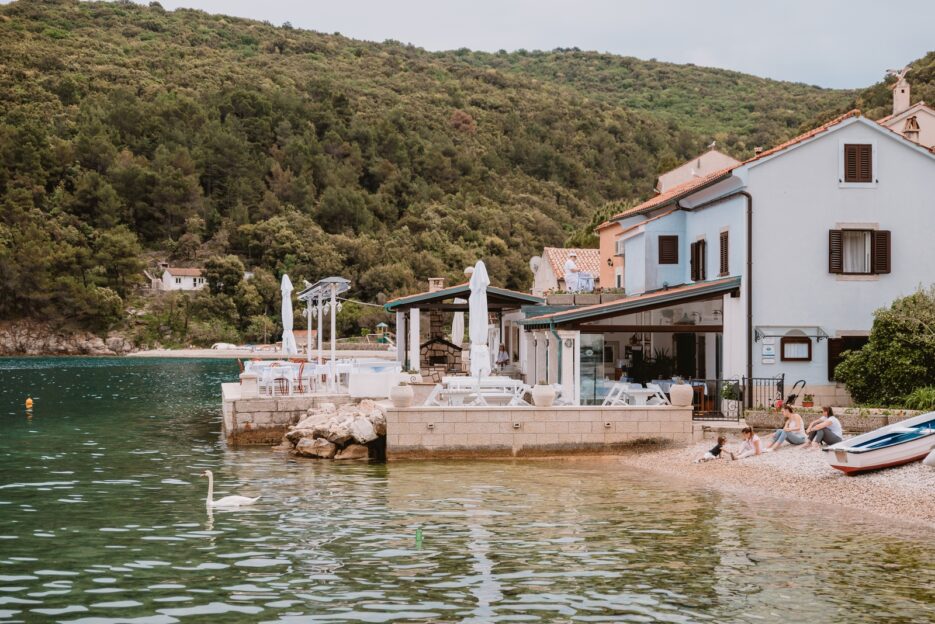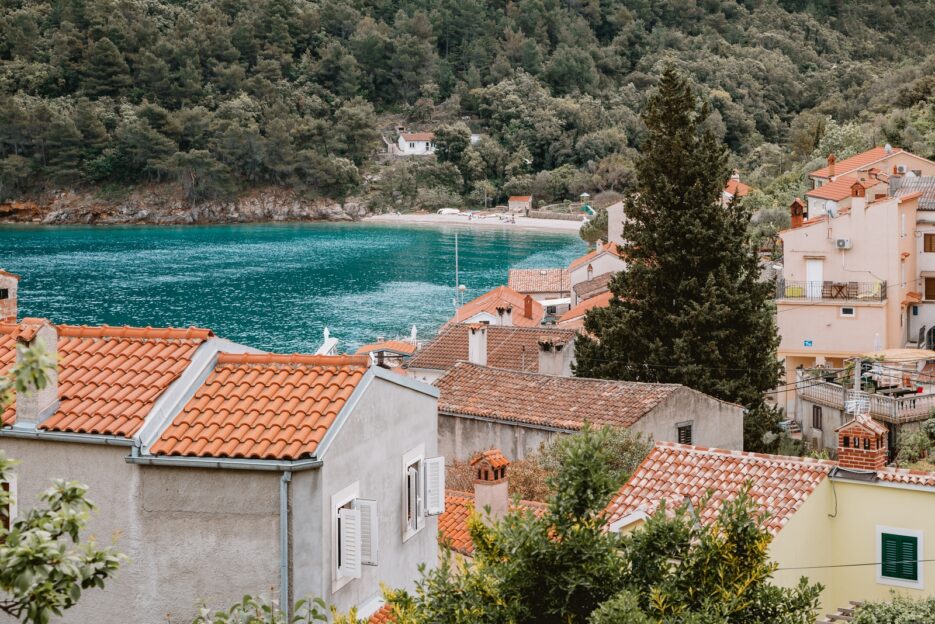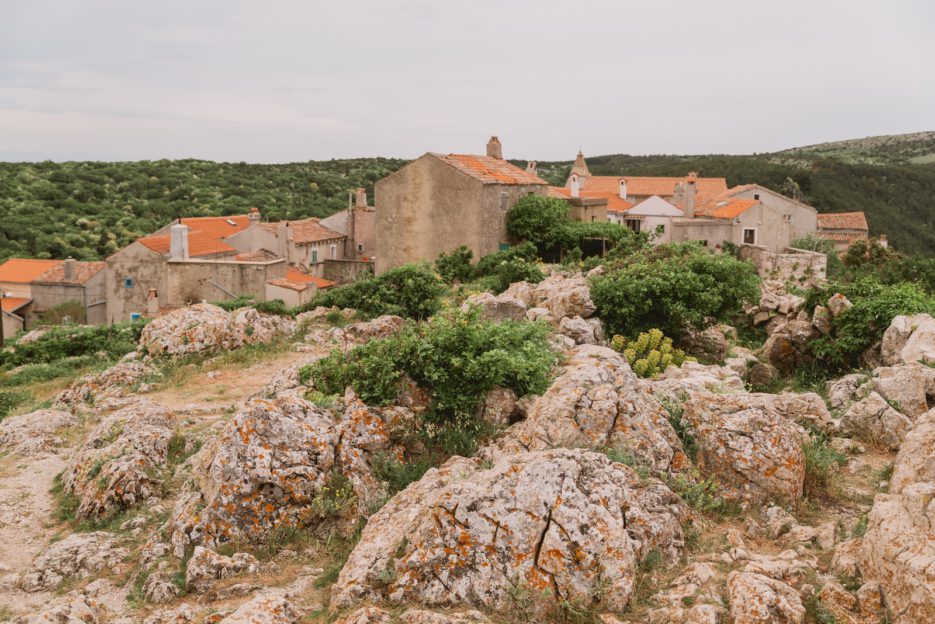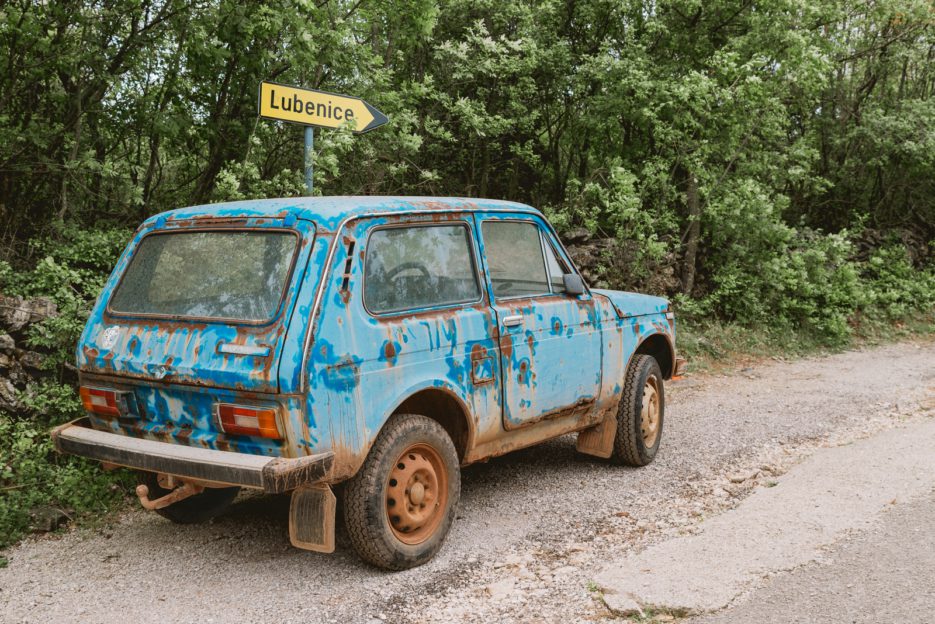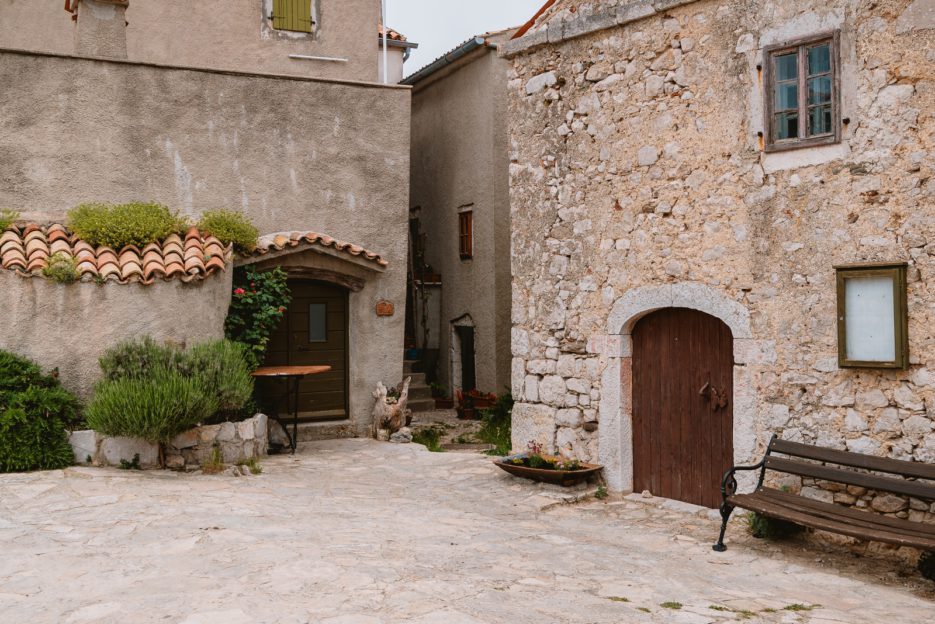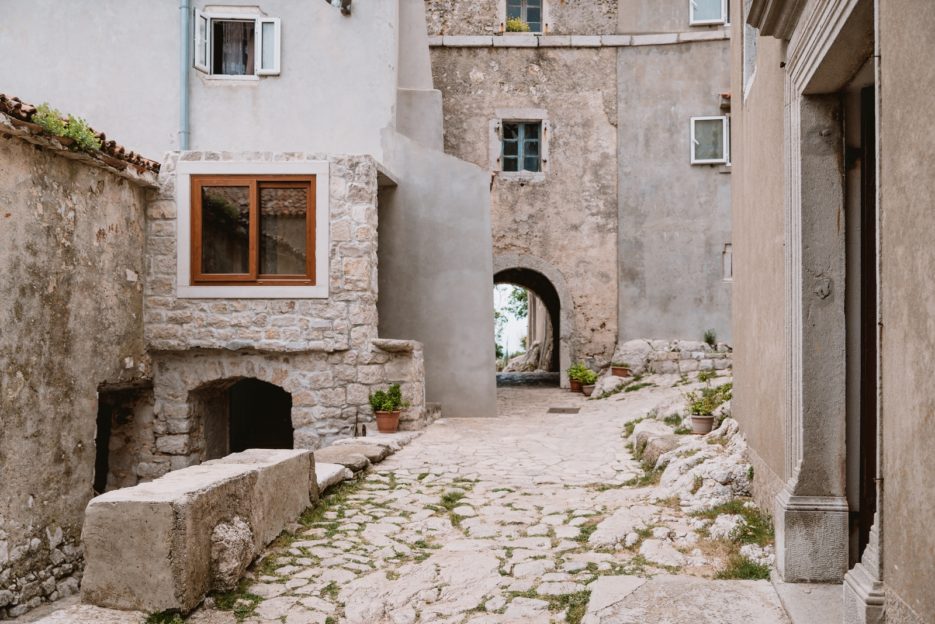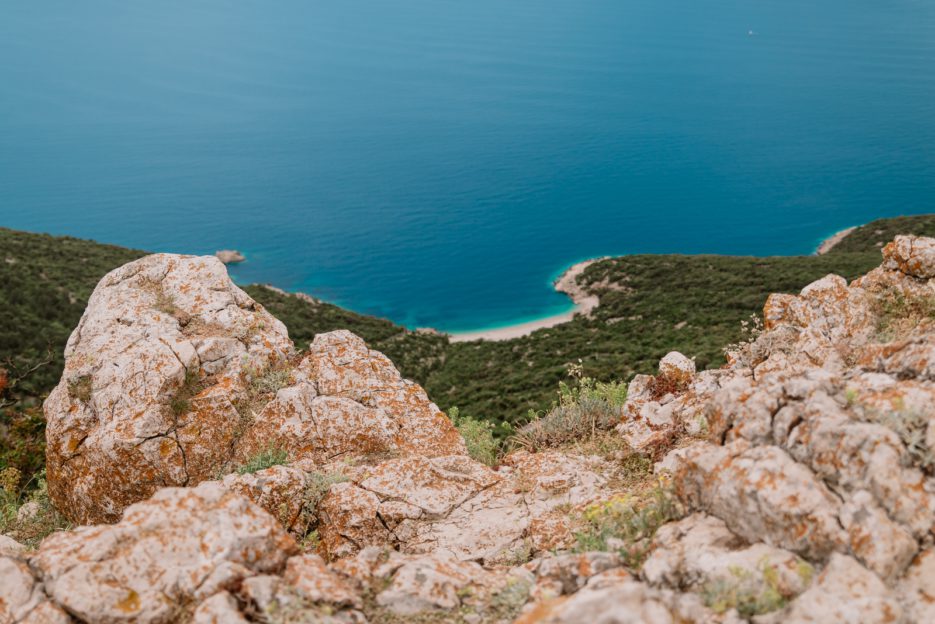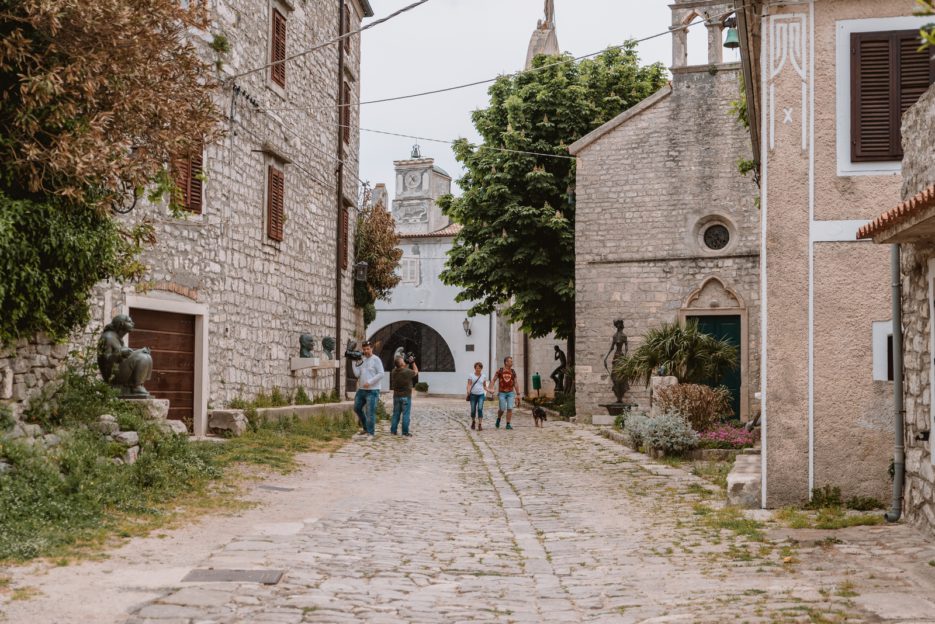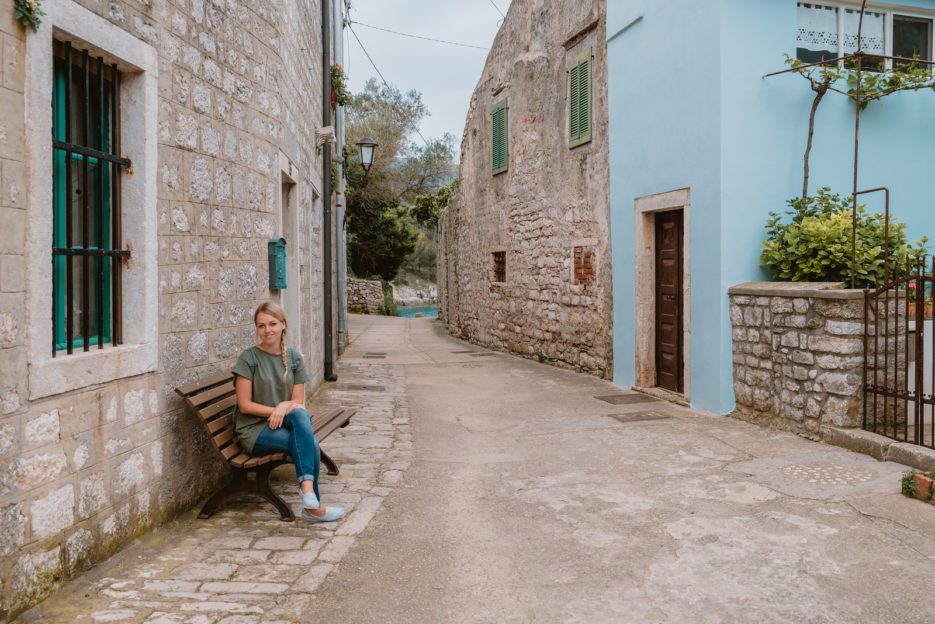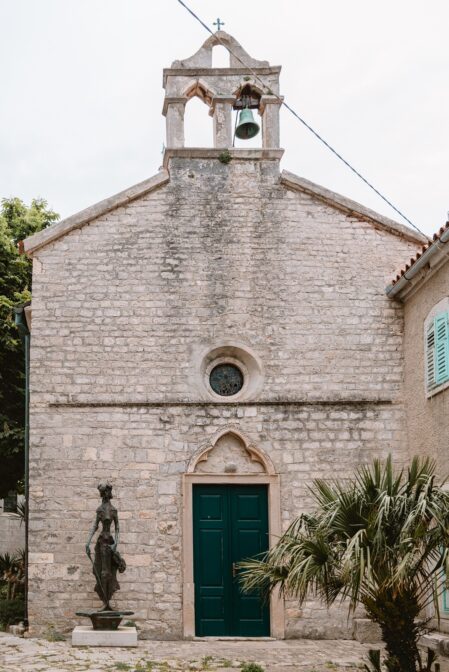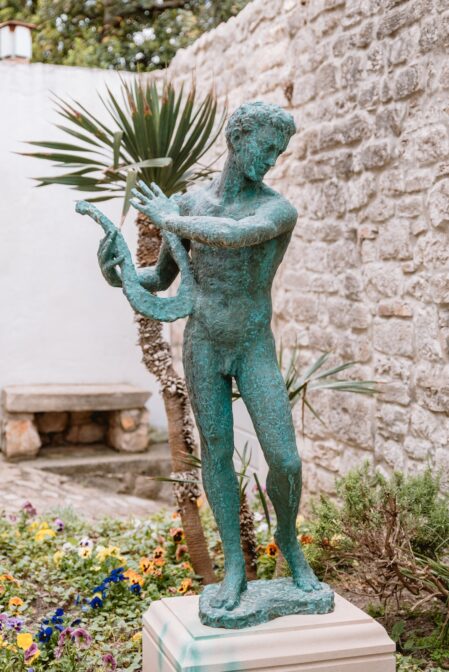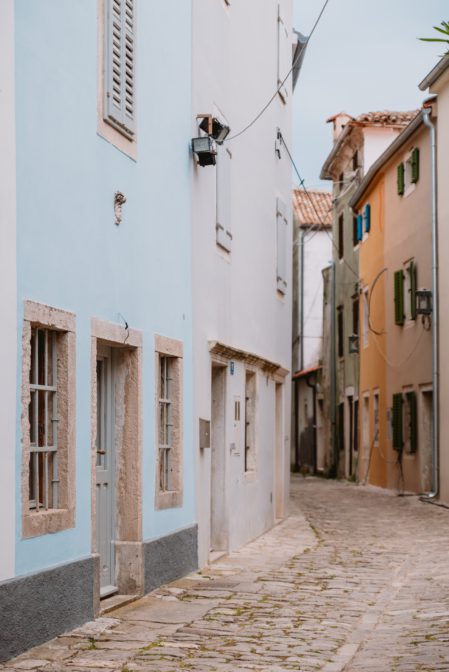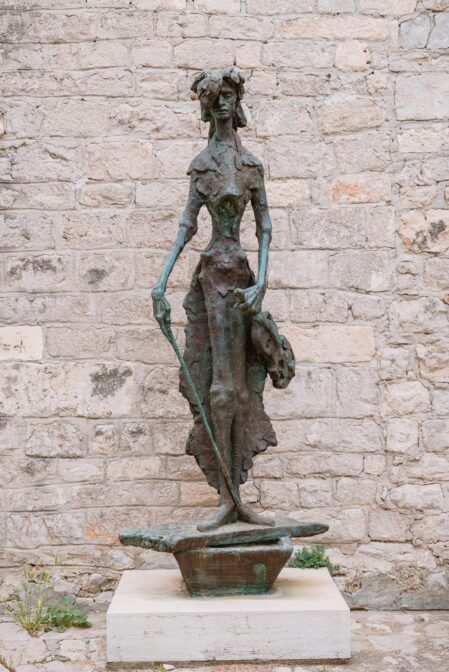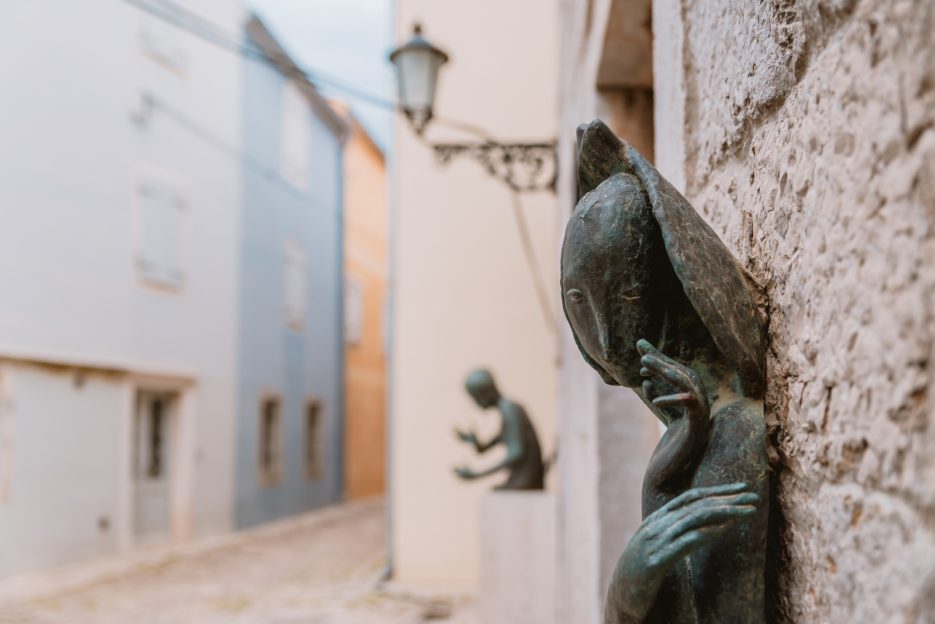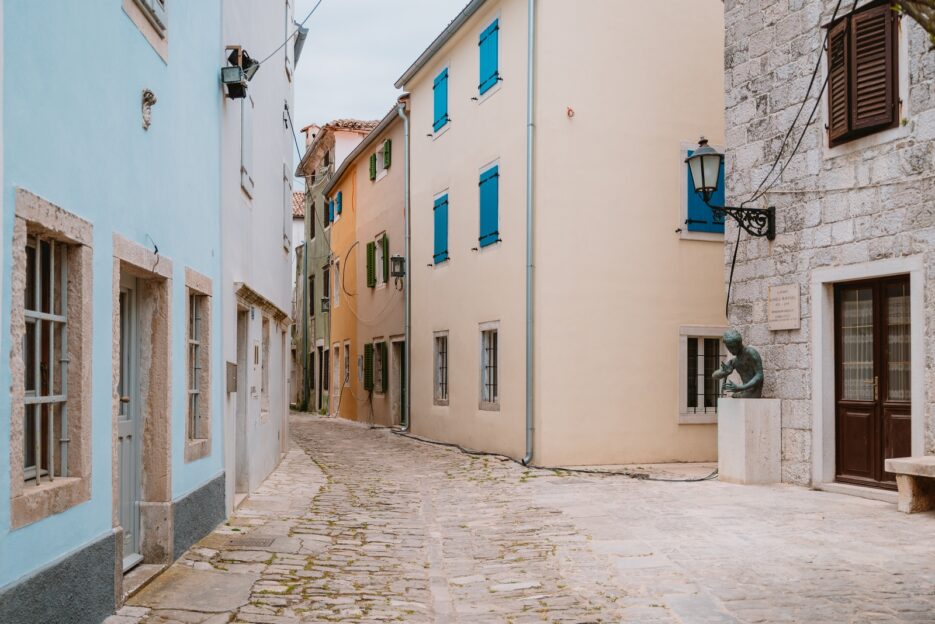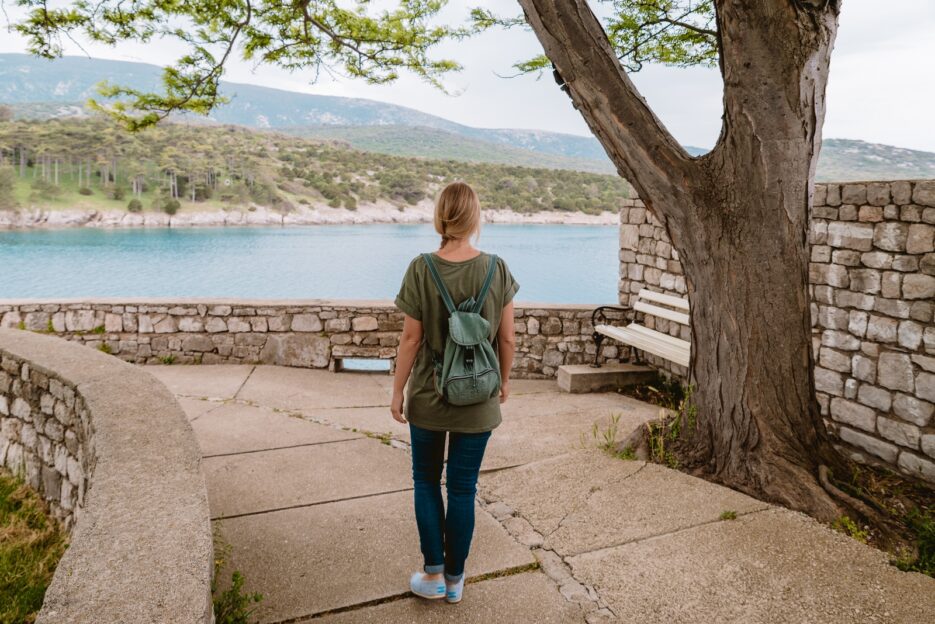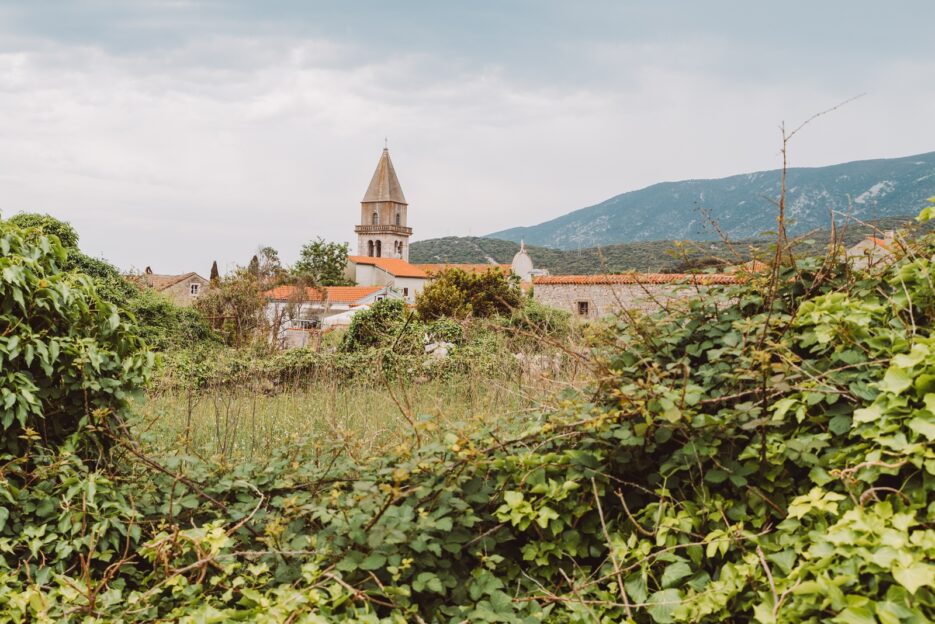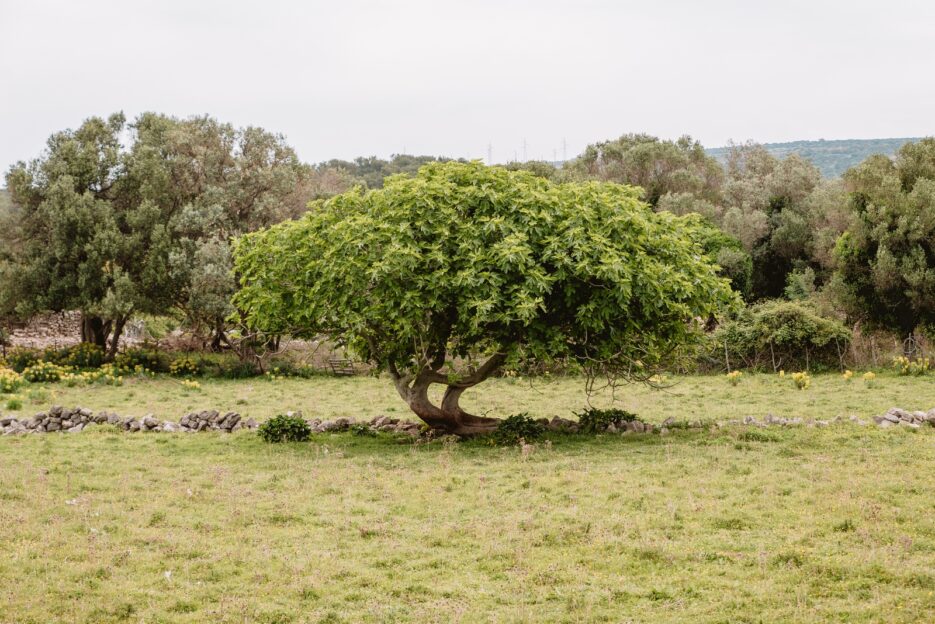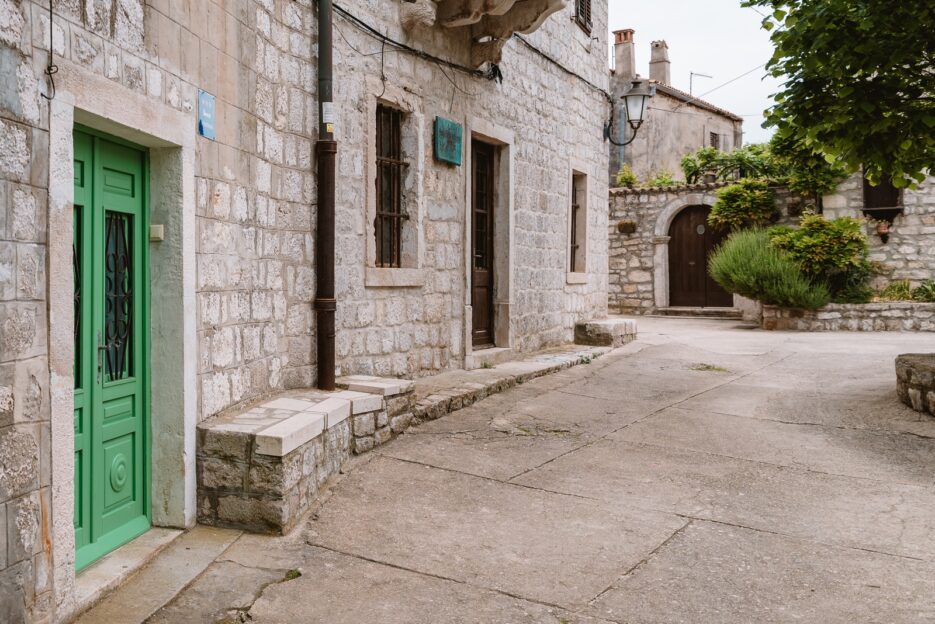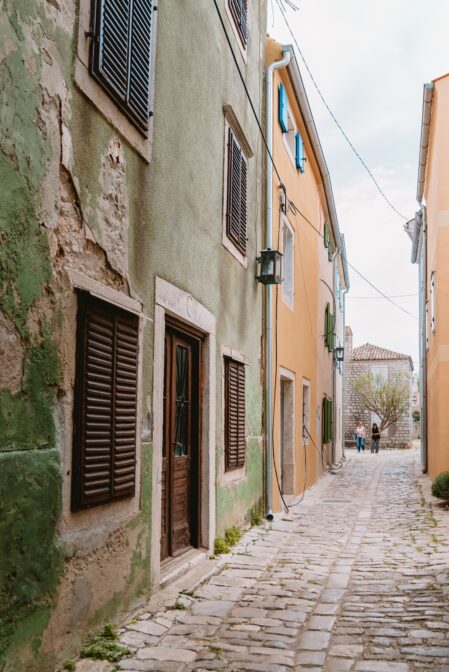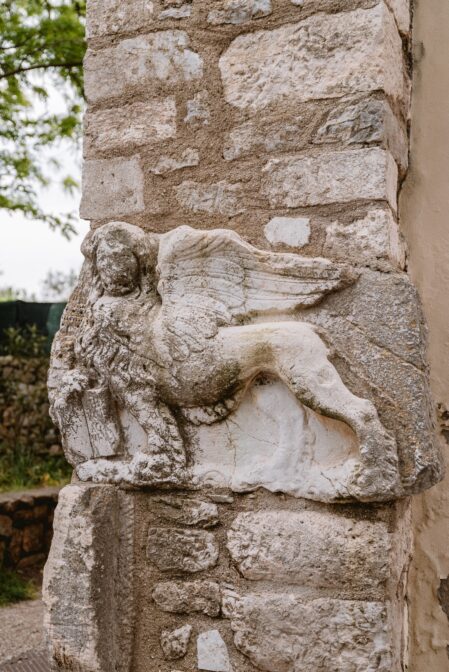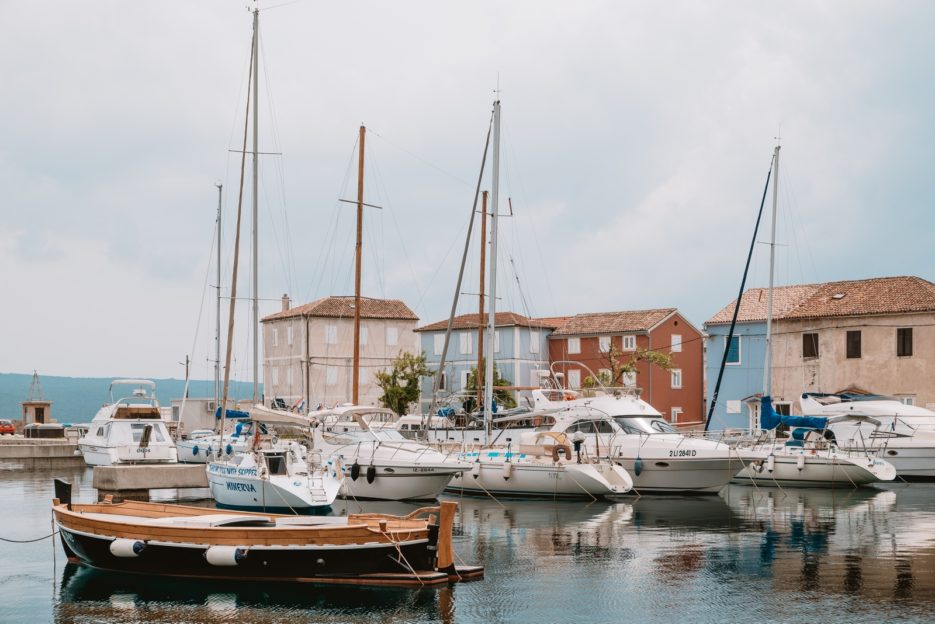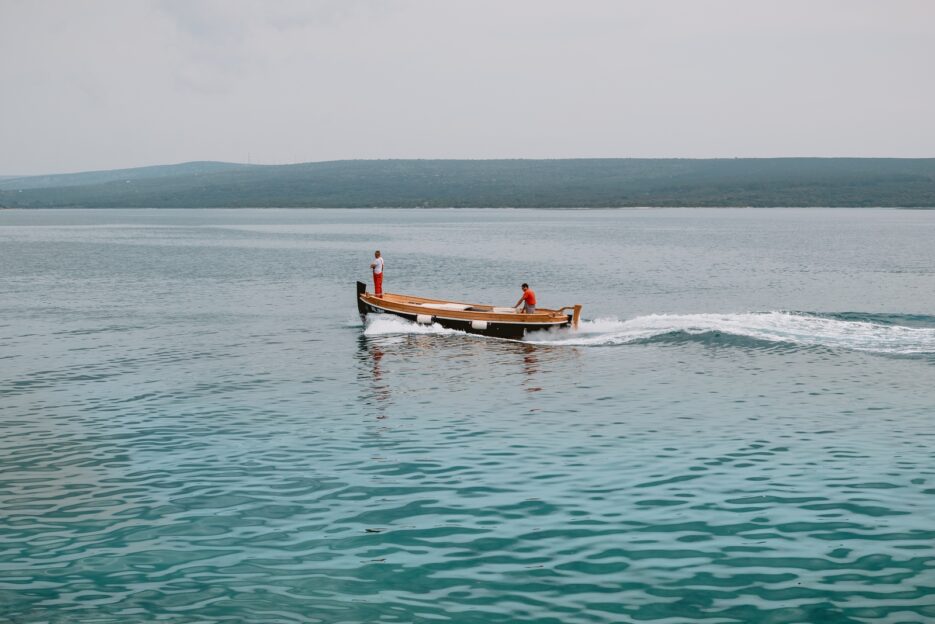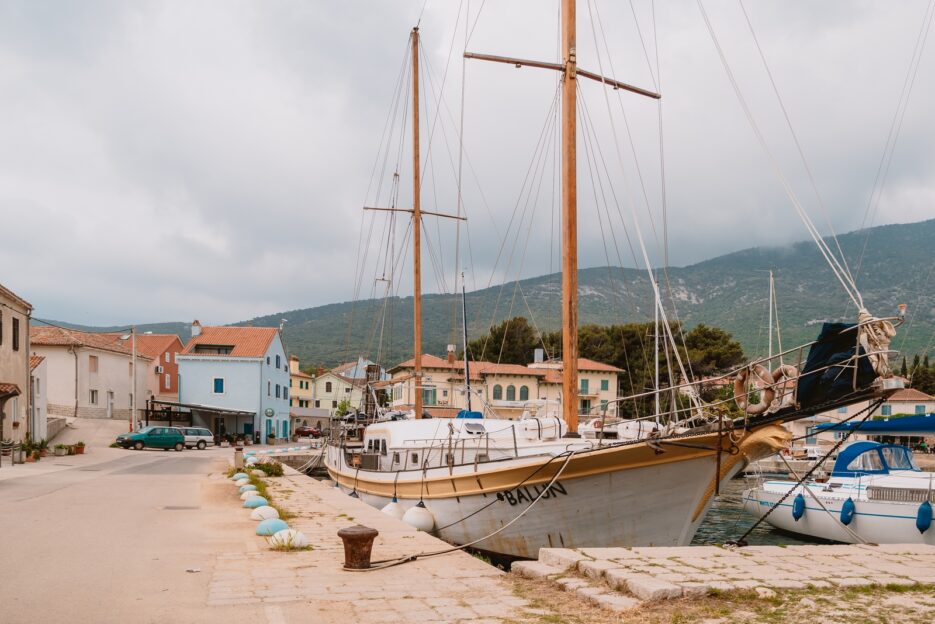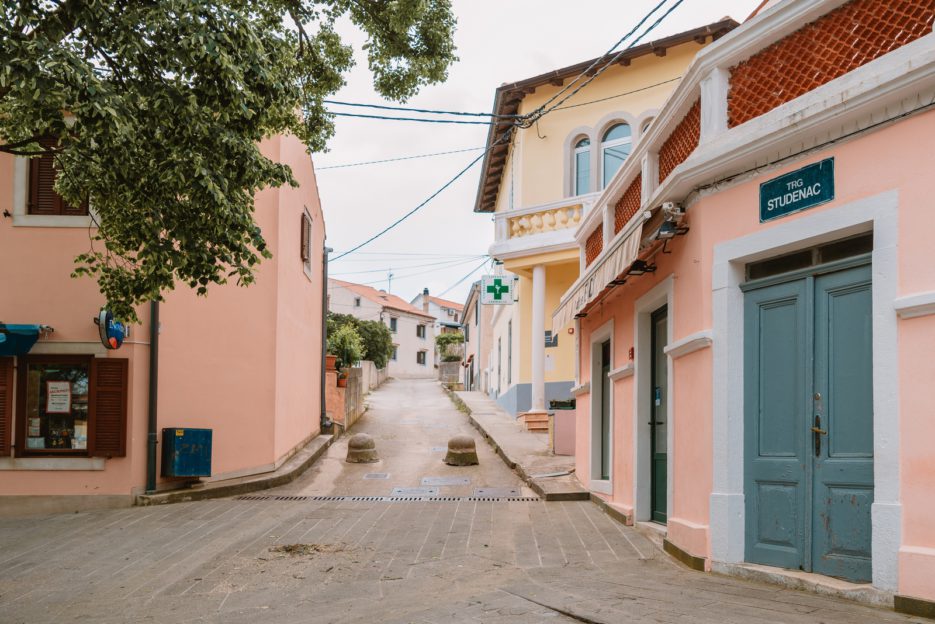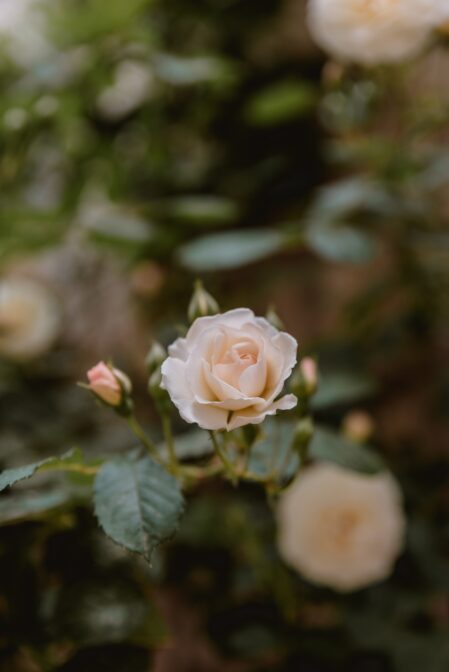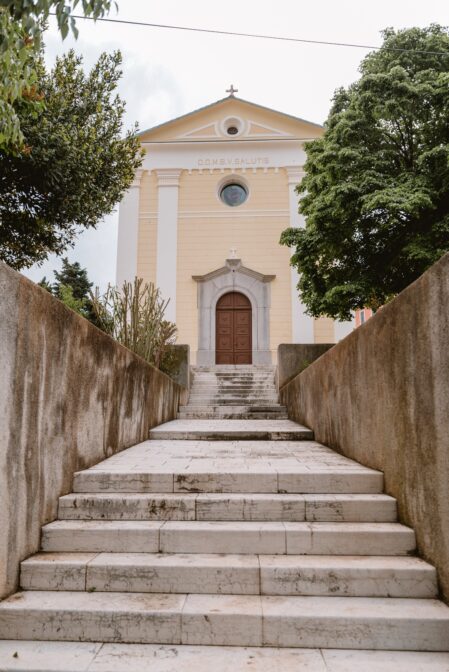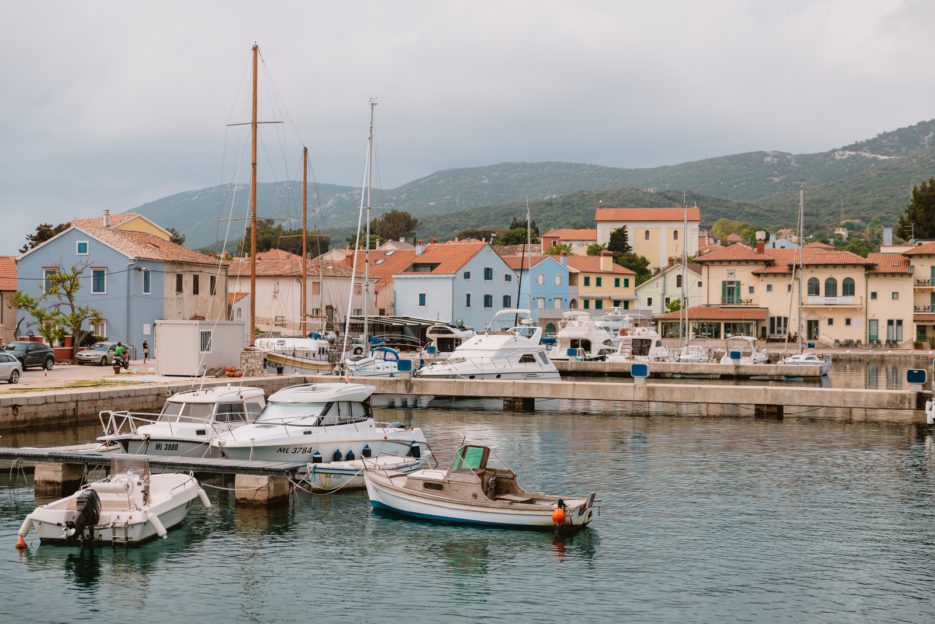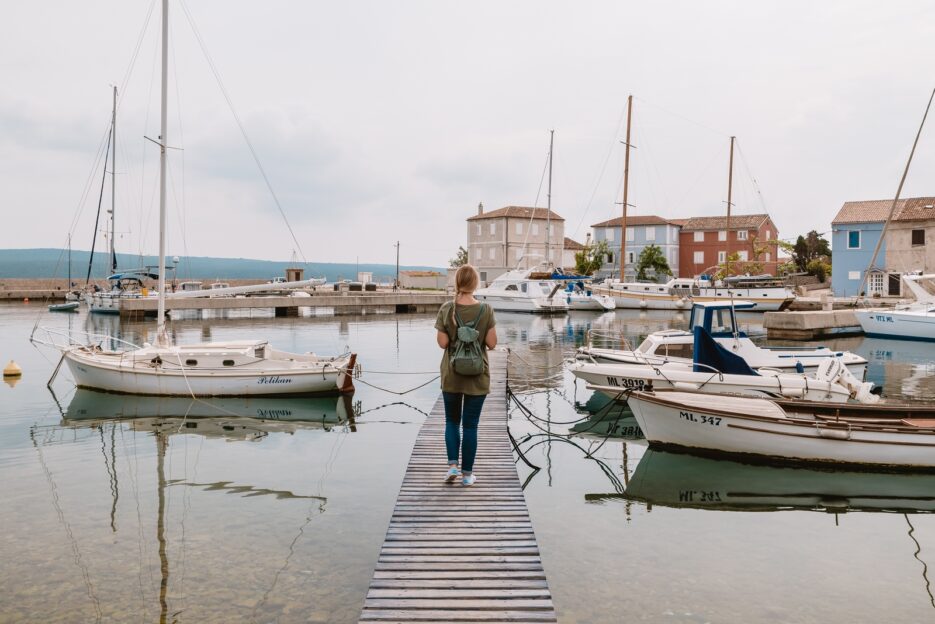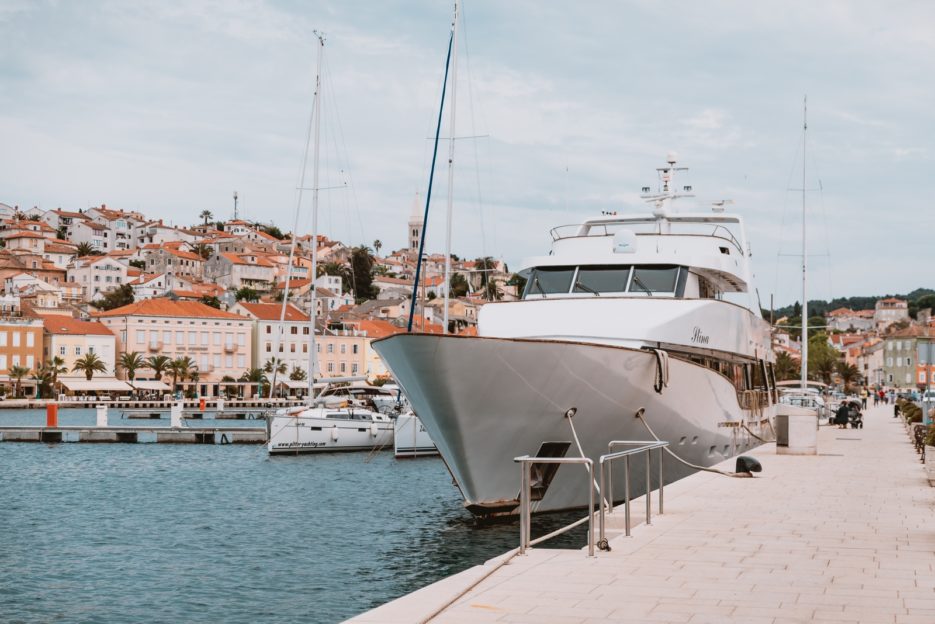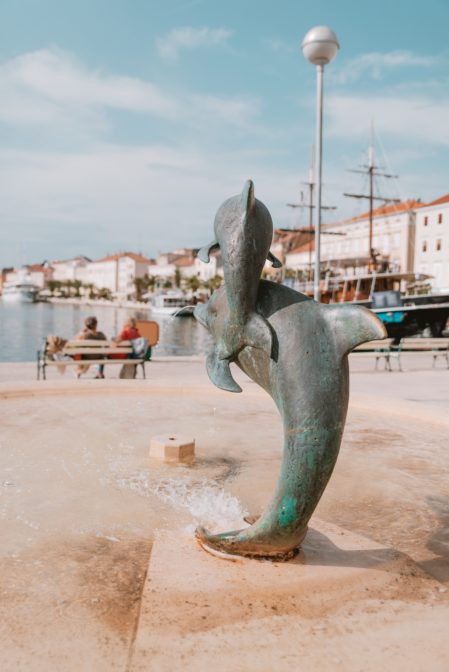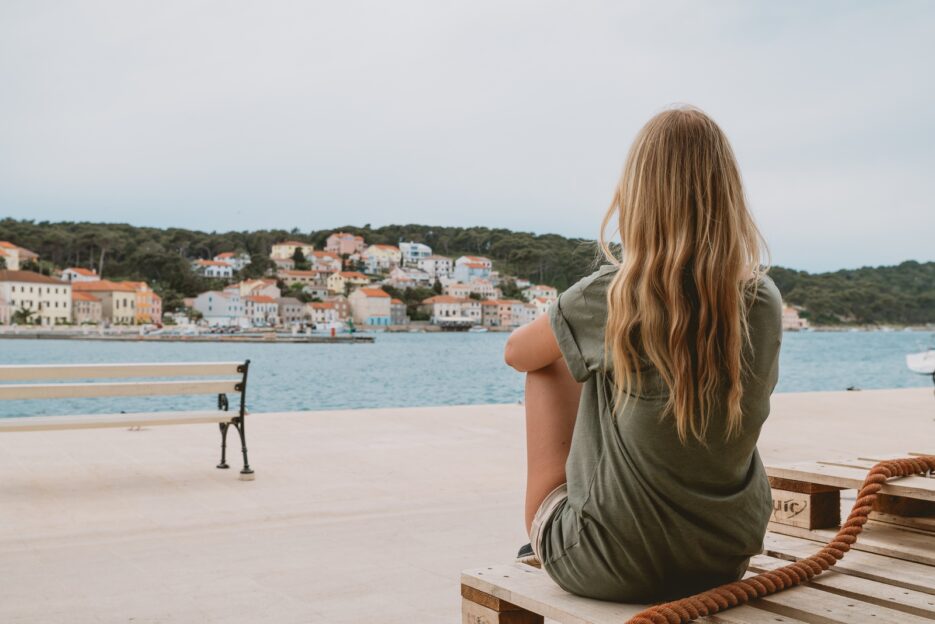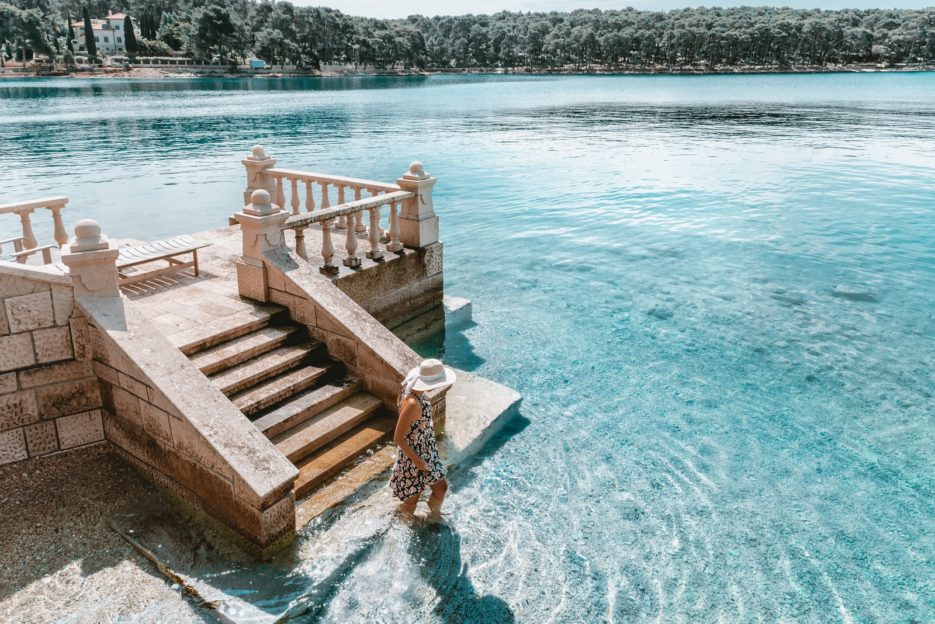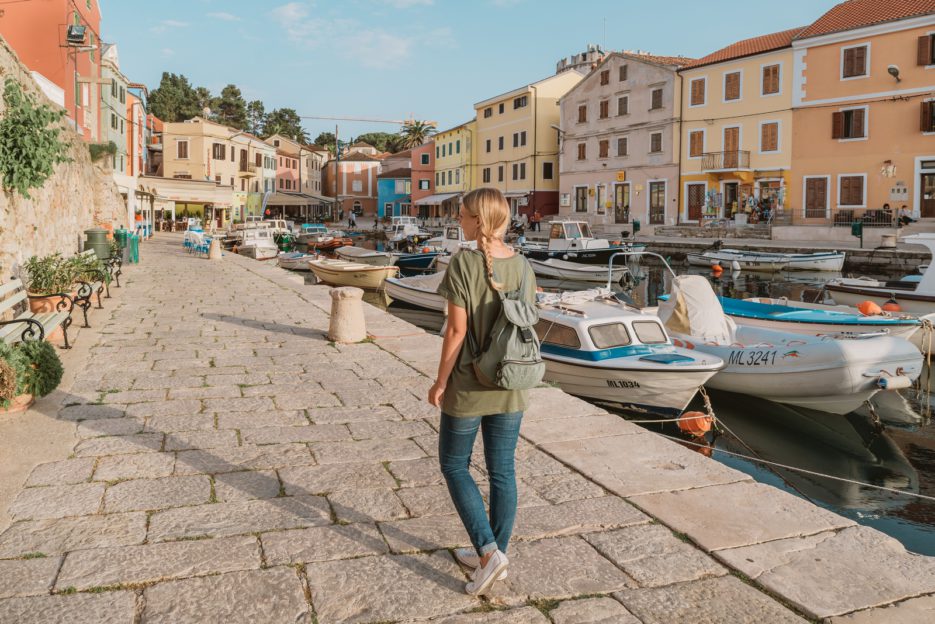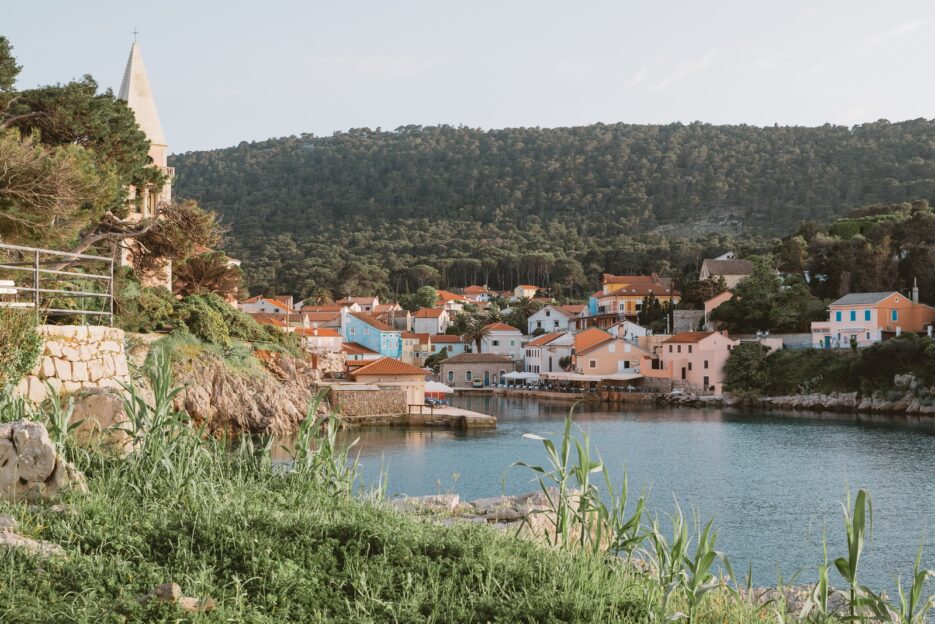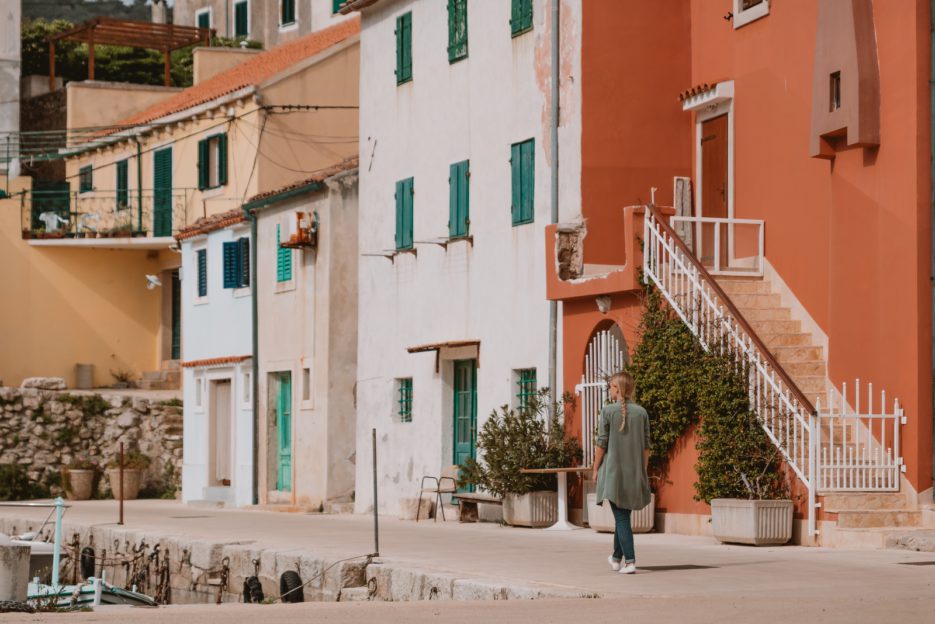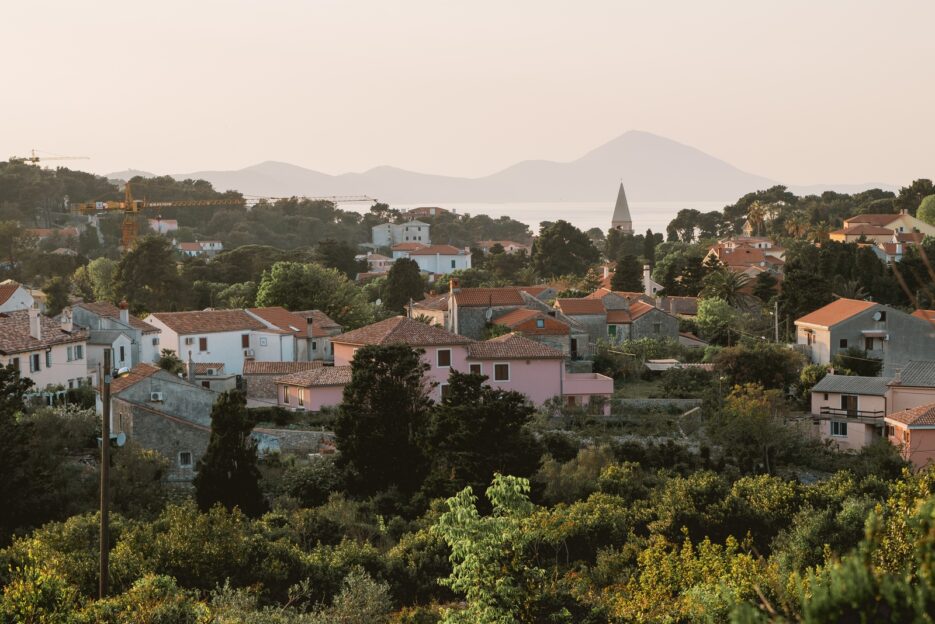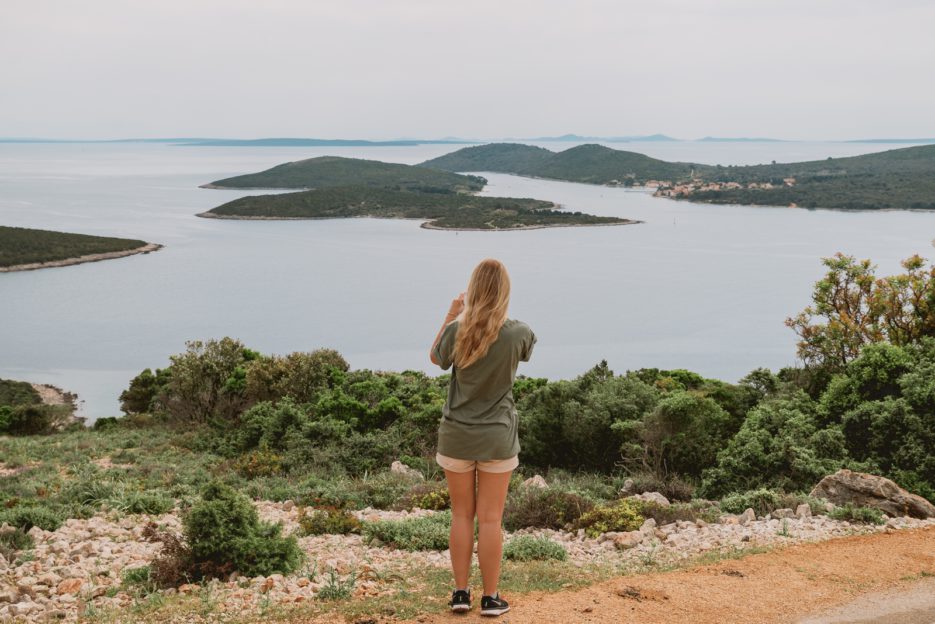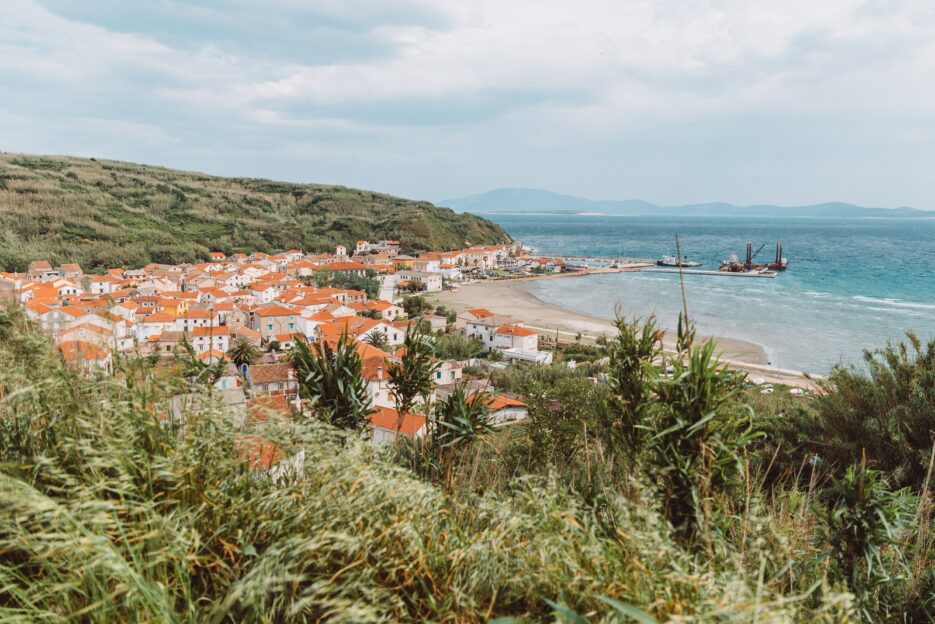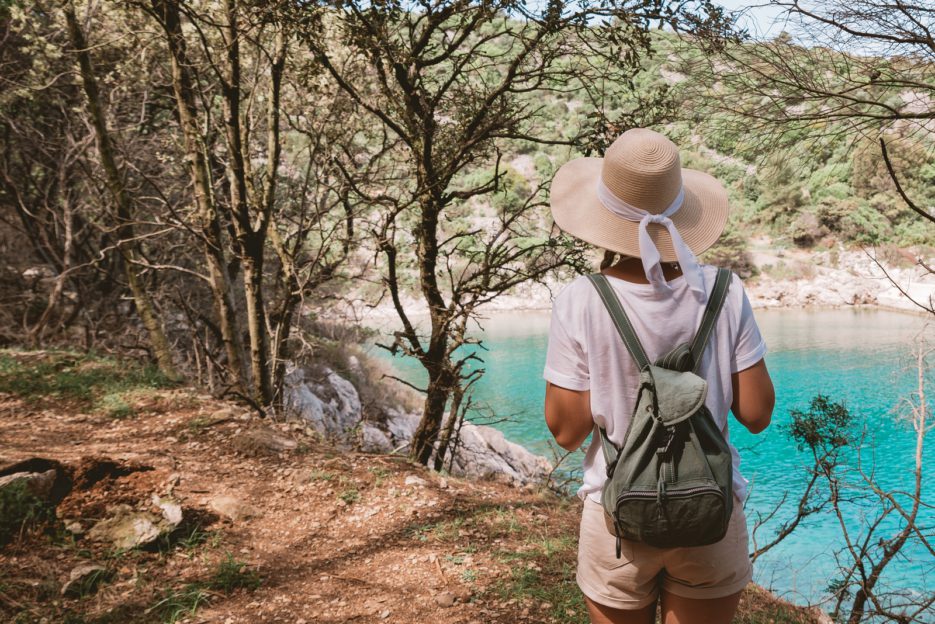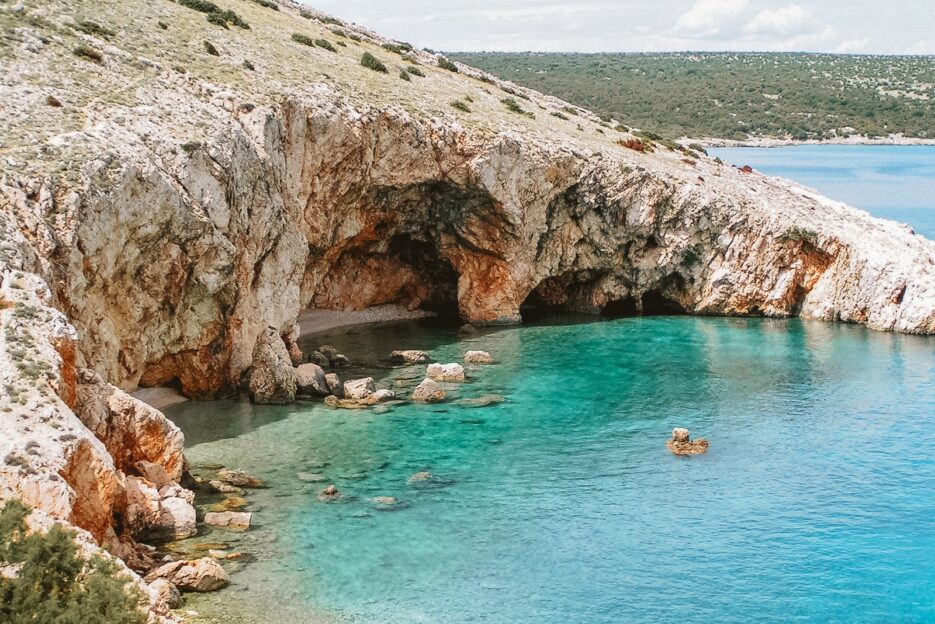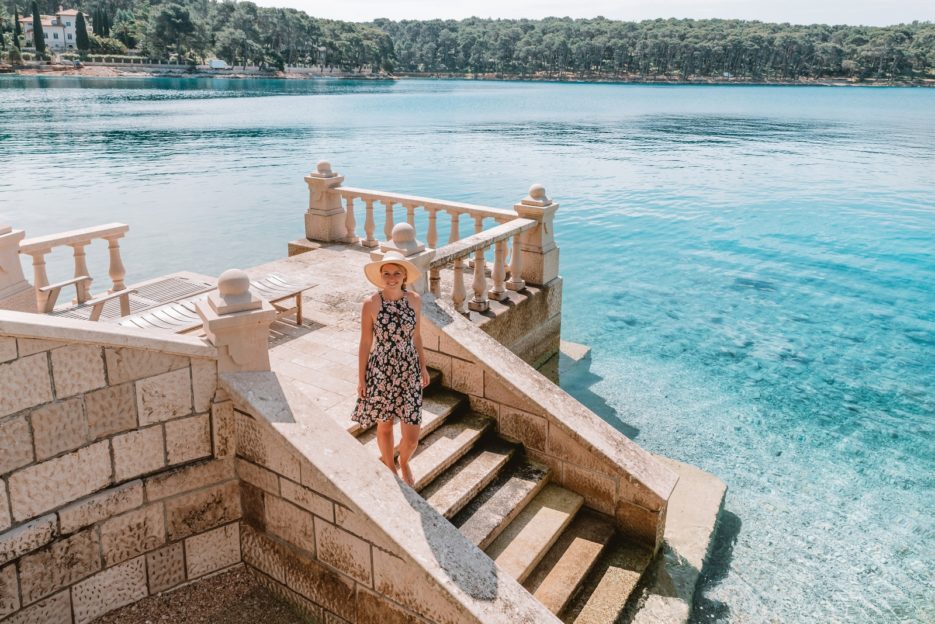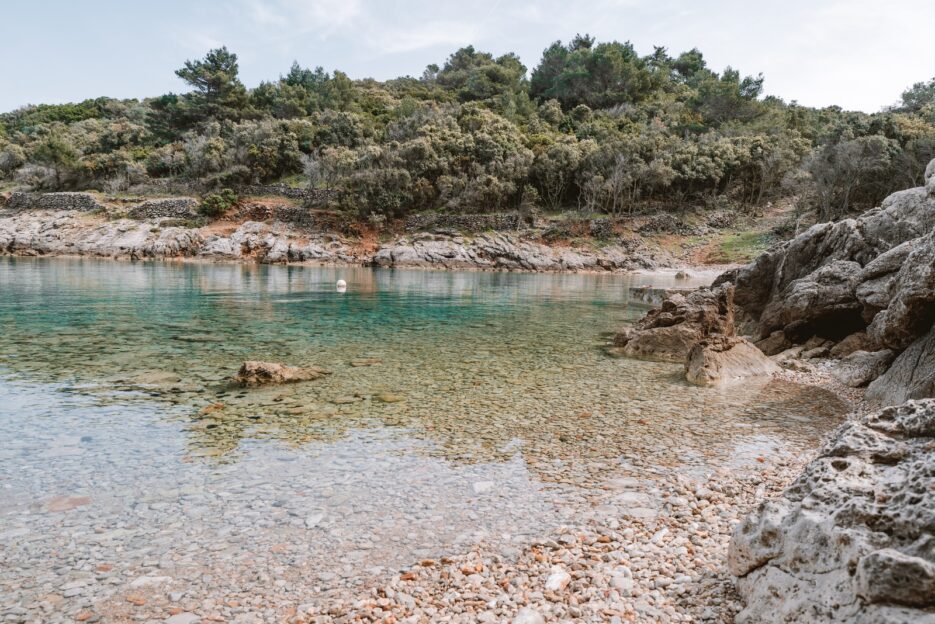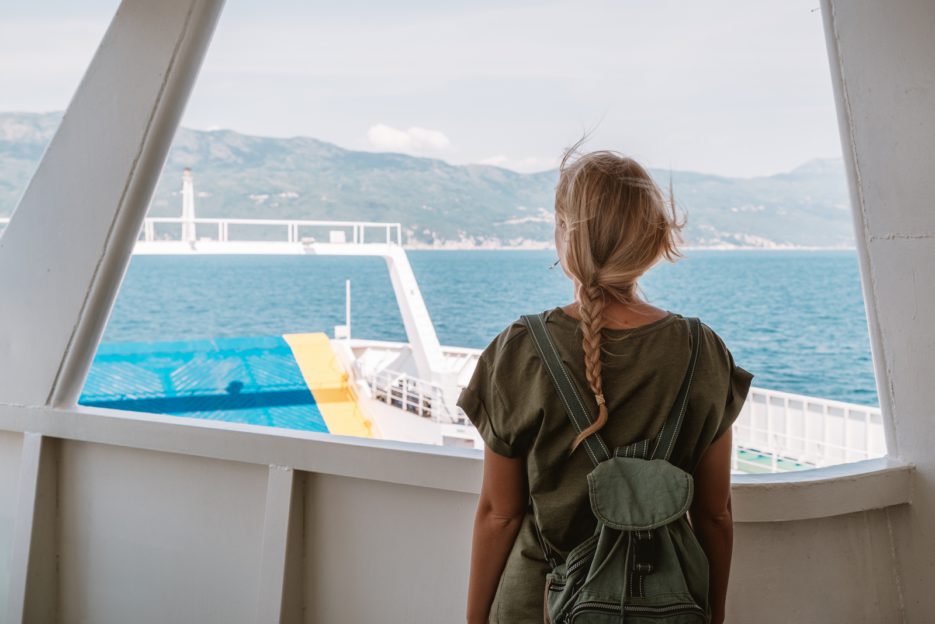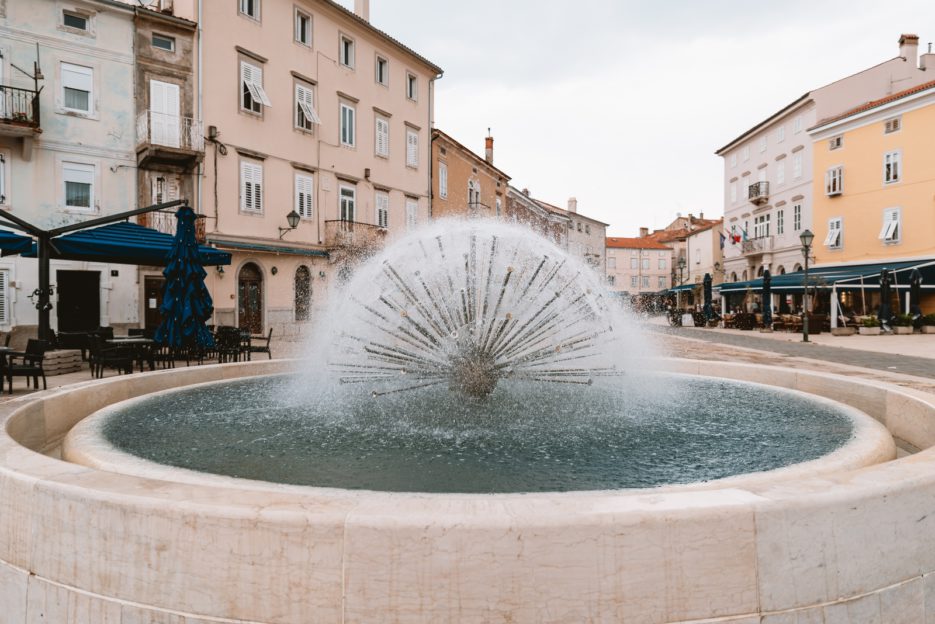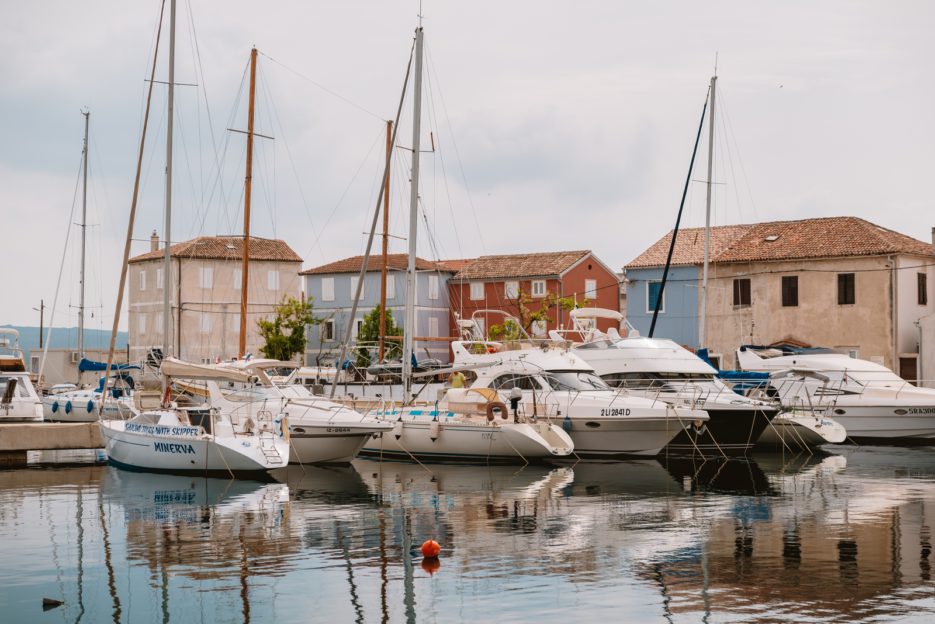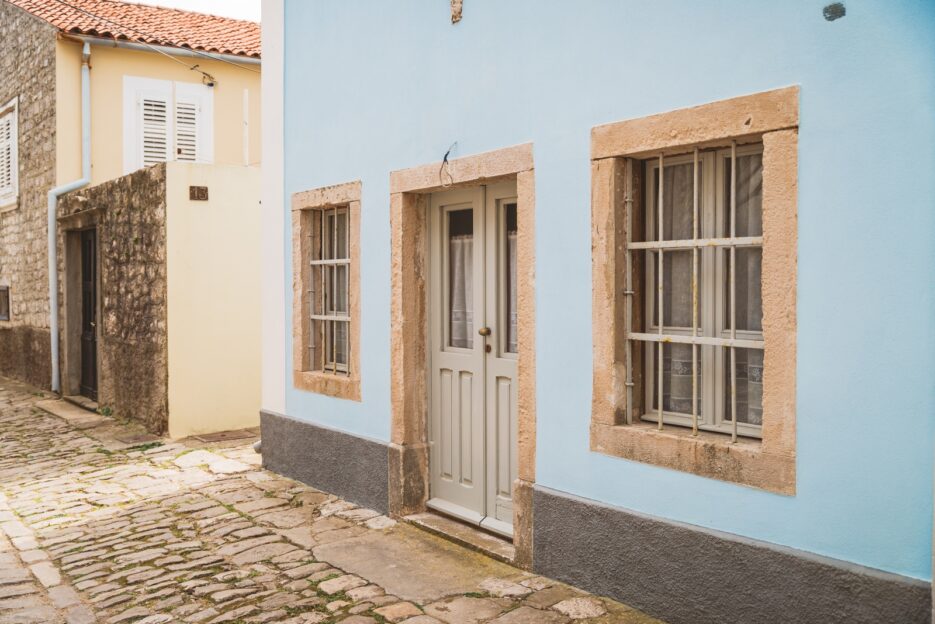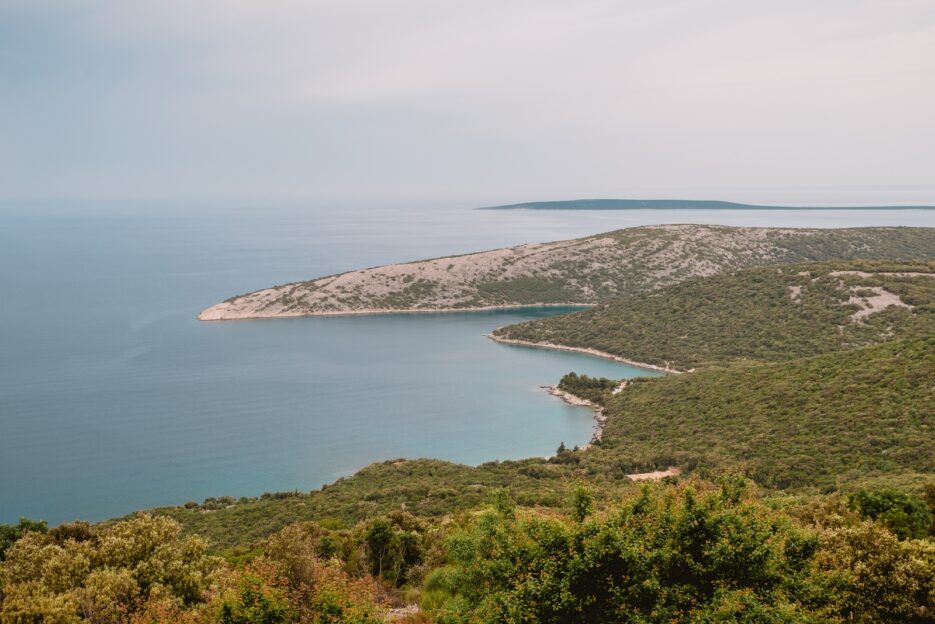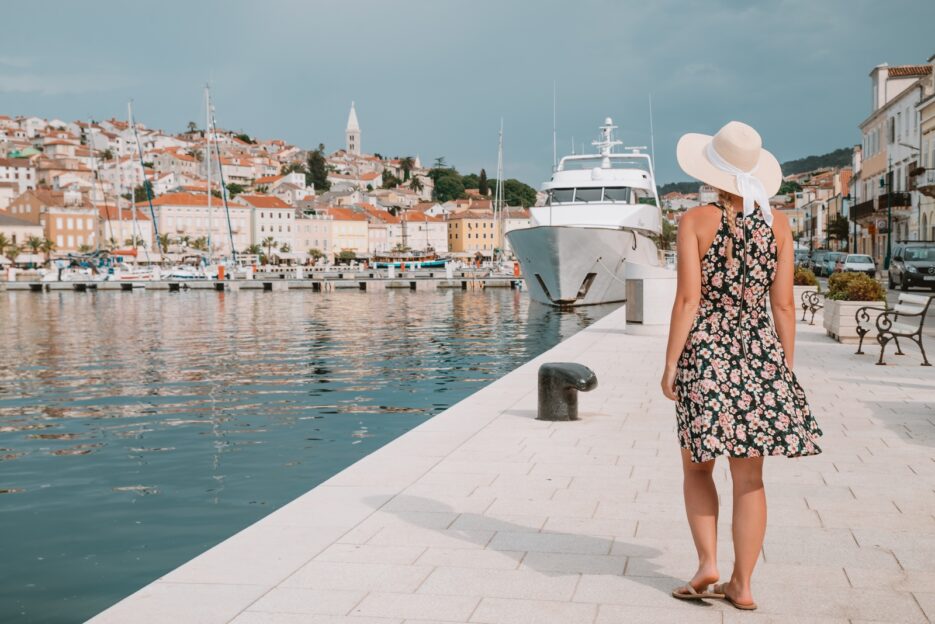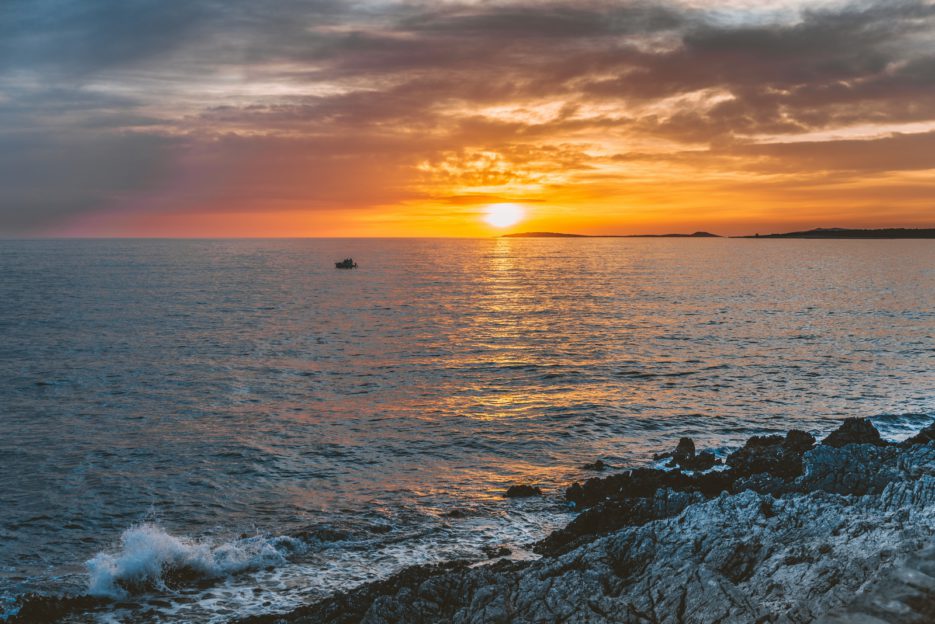The islands of Cres and Lošinj are located in the northern part of Croatia, in Kvarner Bay. I remember the first time I saw them from Cape Kamenjak in Istria. Cres and Lošinj seemed mountainous, mysterious, and inaccessible. Looking at the rough sea and the outline on the horizon, I thought it would be nice to visit these islands someday to find out what they are like. I was curious about towns, hidden beaches, and other things to do in Cres and Lošinj.
My dream came true, and the following spring, we went to Cres and Lošinj. As a result of this trip, I wrote some blog posts about the sandy island of Susak, Veli Lošinj, and Mali Lošinj. However, I did not mention other beautiful places we had seen there. Looking through the photos, I came up with the idea to write about the best attractions of Cres and Lošinj. You can also find some interesting facts and practical information here, for example, how to get to the islands and where to stay. I also mentioned the most beautiful beaches of Cres and Lošinj and expressed my opinion on whether it is worth visiting these islands.
Cres and Lošinj, beautiful islands in northern Croatia
The islands of Cres and Lošinj are located in the northern part of Croatia, in Kvarner Bay. Even though they are so close, they are like two completely different worlds. The island of Cres is a mountainous, harsh landscape, with steep slopes whipped by the wind and flocks of sheep grazing among the maquis. After entering Lošinj, the rocky desert suddenly turns into a green oasis with lush palm trees and fragrant, colorful flowers. Cres is a paradise for loners, hikers, and those who like secluded beaches. Lošinj is favored by yacht crews and tourists looking for picture-perfect towns and the atmosphere of a seaside resort.
A fun fact is that in ancient times, Cres and Lošinj were one island called Apsyrtides. When the Romans came here, they dug a 6 m wide and 3 m deep canal, which significantly shortened their journey to the south. Thus, the largest island in the Adriatic Sea was divided into two parts. Merchant ships no longer had to circumnavigate the whole island, which was time-consuming and dangerous in bad weather conditions. Instead, they sailed through a narrow isthmus in the town of Osor.
Nowadays, the islands are connected by a swing bridge that opens twice a day, at 9 am and 5 pm, to allow small boats, yachts, motorboats, and sailboats to pass through. When traveling by car, please remember that crossing the bridge is impossible during these hours. The waiting time is about 30 minutes.
Top 10 things to do in Cres and Lošinj, Croatia
There are many things to do on the islands of Cres and Lošinj. You can find both picture-perfect old towns with narrow streets here as well as forgotten villages where time stood still. There are also beautiful secluded beaches and scenic mountain trails with breathtaking views of Kvarner Bay. Regardless of interests and tastes, I think there is something for everyone here.
What are the best places to visit in Cres and Lošinj? I decided to answer this question by creating a list of the top 10 attractions of Cres and Lošinj. This is not a ranking but rather something like a guide or a virtual journey. We will start the trip on the harsh and mountainous Cres Island, heading south towards Veli Lošinj. Towns, beaches, small islands of the archipelago, and ferry crossings mentioned in the article have been marked on the map above.
1. The romantic old town of Cres.
The city of Cres is the capital and the main administrative center of Cres Island. Situated in a wide secluded bay, it is surrounded by green hills covered with olive groves. At first glance, Cres looks like a typical Italian town. Walking around the port and the streets in the old city, you can notice the Venetian influence. Cres was built in the Middle Ages on the plan of the ancient Crepsa fortress, but the greatest boom occurred under the Venetians in 1459 when the city became the capital of the Cres-Lošinj archipelago. Thus, it replaced Osor, which lost its importance.
The center of Cres is Frane Petrić Square, with the Clock Tower and a 16th-century town loggia. In the past, declarations were read in this place, punishments were meted out, contracts were concluded, and holidays were celebrated. Nowadays, it serves as a morning marketplace where islanders sell fruits, vegetables, olive oil, honey, and other local products.
There are numerous cafes and restaurants where you can stop by for a cup of espresso or try the local cuisine. The town of Cres is also full of boutiques and small shops that offer all sorts of homemade products, souvenirs, and jewelry. Grocery shopping can be done in Konzum and Plodine supermarkets, the only ones on Cres Island.
The best way to feel the atmosphere of Cres is to walk through its medieval part, which consists of a maze of narrow streets and tall, adjacent tenement houses. On the facades of some buildings, you can still see the coats of arms of the families living there and emblems that inform about the occupations performed in the past, like fishermen, farmers, and blacksmiths.
In the past, the old town was surrounded by fortifications that consisted of defensive walls and five towers. You could get to the center by one of three city gates – Porta Bragadina, Porta Marcella, and the passage under the clock tower, which leads to St. Mary’s Church from the late 15th century (Crkva sv. Marija).
Wandering through the narrow streets of the medieval city, you can discover many pretty corners and architectural gems. It is worth paying attention to the 13th-century Church of St. Isidore (Crkva sv. Sidar) and the former seats of the patricians: the Renaissance Moise Palace and the Gothic-Renaissance Arsan Palace, which houses the Municipal Museum. One of the must-see attractions is Creska kula, a defensive tower that provides a nice panorama of the city.
If I had to choose two attractions of Cres that impressed me the most, my picks would be the Porta Marcella city gate with the Venetian lion and the Franciscan monastery. We visited the slightly off-the-beaten-path monastery at the beginning of the trip and discovered the Porta Marcella gate by accident when we got lost in the maze of streets of the old town.
I remember that we parked our car near the shipyard, and while walking toward the center of Cres, we noticed an enormous Easter egg in front of the church. We went closer to look at it and found a passage that led through a courtyard to a garden with an olive grove. We spent a long time in the Franciscan monastery, admiring the beautiful architecture and contemplating the unique atmosphere of this place. If you take a trip to Cres, don’t miss this hidden gem.
Cres is one of the few places on the islands of Cres and Lošinj where you can stroll through the narrow streets, visit museums, buy souvenirs, and do some grocery shopping. There are also restaurants, cafes, ice cream parlors, and pubs. If you want to go out in the evening or do something on a rainy day, I think a trip to Cres will be a hit. In my opinion, the city is worth visiting, but keep in mind that in terms of architecture and atmosphere, it resembles more Italian towns than the places typical for Dalmatia.
2. Beli, home of the griffon vulture.
“Wanderer, let wisdom illuminate your paths, and let your heart guide you through beauty to the truth.” – says the inscription on the stone gate in Beli. Walking through the narrow streets, it’s hard to believe that Beli used to be one of the largest and most populated settlements on Cres Island. Situated on top of a hill, it looks like some of the towns I’ve seen in the interior of the Istrian peninsula. You can get here by a narrow road that climbs a steep slope and leads through dense oak and alder forests. Although the capital city of Cres is only about 19 km away, it feels like the end of the world.
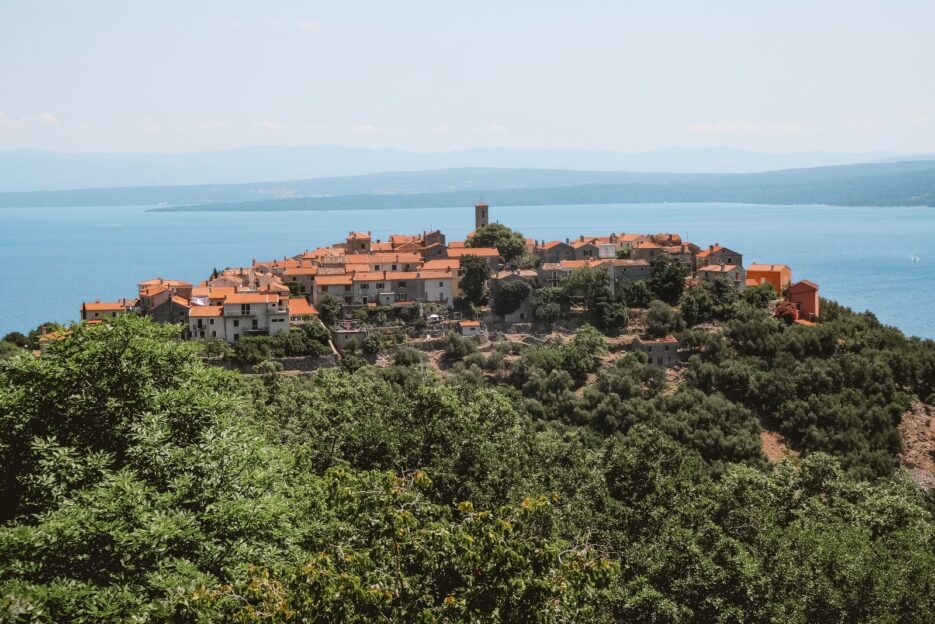
Beli, home of the griffon vulture, Hermann Junghans, CC BY-SA 3.0 DE, via Wikimedia Commons
Beli is one of the oldest villages on the island of Cres, with a tradition dating back 4000 years. Due to its strategic location, during the Roman Empire, the town was called Caput Insulae, which in Latin means: Head of the Island. One of the must-sees in Beli is the stone bridge over the Potok canyon, which is the legacy of the former inhabitants of the settlement. It is worth mentioning that it is the only Roman bridge on the eastern coast of the Adriatic that was preserved completely.
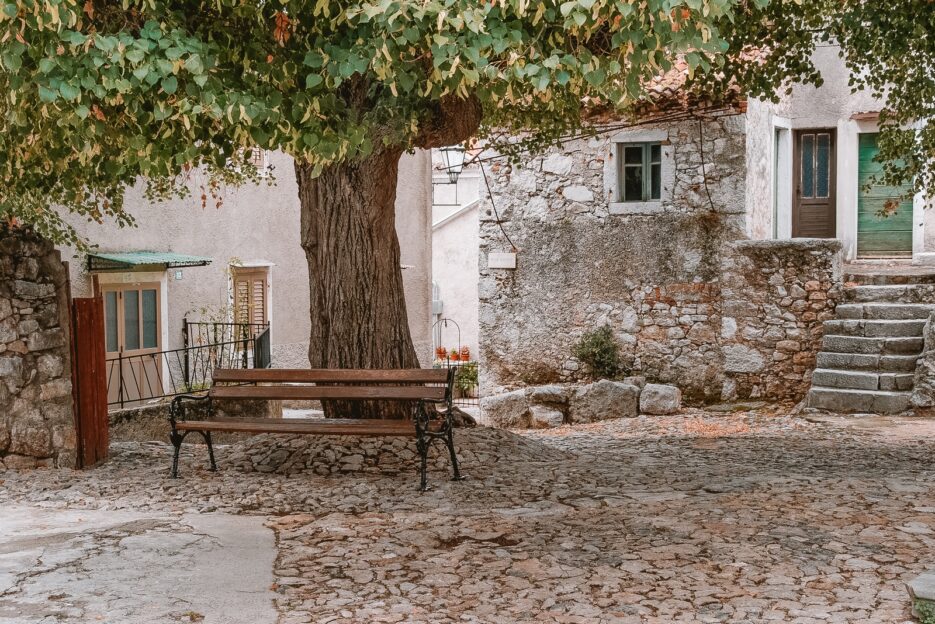
Beli, a beautiful village on the island of Cres, Alexander Leisser, CC BY-SA 4.0, via Wikimedia Commons
Although Beli has only 40 permanent residents, it has retained the features of a city to this day. The central point and meeting place is an amphitheater-like square with stone seats. There is also a public water cistern, a municipal loggia, and several sacral buildings, including the small Romanesque Church of St. Mary (Sv. Marije) with a collection of valuable crosses from the 13th-14th centuries. Walking along the narrow streets, you can see some remains of Glagolitic inscriptions on the houses. It is also worth visiting Beli to see the griffon vultures inhabiting the coastal rocks. Since 1993, the ecological club Eko Centrum Caput Insulae has been operating in the village, which, in addition to protecting nature and monuments, also helps the weak and sick birds.
3. Valun, a place called Croatian Saint-Tropez.
Valun is a small town on the island of Cres, which in some guidebooks is called Croatian Saint-Tropez or Portofino. I never take such comparisons seriously, but I decided to see for myself what all the fuss was about. I was expecting a hidden gem with beautiful architecture and a magical atmosphere, but to be honest, I was a bit disappointed.
The fishing village of Valun is situated on a small bay, sheltered by the Pernat promontory. It is a cluster of colorful houses rising on a steep green slope. The center cannot be reached by car. You have to leave it in the parking lot above the village and go down the steep streets to the port. Luggage and other large items can be transported on wheelbarrows.
They say that in Valun you can eat delicious fish and seafood. Some people get there specifically for lunch or dinner, so there are quite a few restaurants on the waterfront that are pretty expensive and tourist-oriented, in my opinion. However, Vanun has some beautiful pebble beaches where you can find peace even in the high season. For history lovers, I recommend a visit to the Church of the Blessed Virgin Mary, where you can see the famous tablet from Valun (Valunska ploča), a bilingual (Old Croatian and Latin) and written in two alphabets (Glagolitic and Latin) monument of writing from the 11th century.
I wasn’t sure whether to mention Valun on my list of top 10 things to do in Cres and Lošinj. The village did not impress me much, but it has many positive reviews. Some people even said they had the best vacation here, so maybe I missed something important during my short visit. Anyway, I will not suggest anything. It’s best to come and see for yourself.
4. Lubenice and Sveti Ivan beach.
The nearly 4,000-year-old Lubenice settlement feels like at the end of the world. The village is situated on the edge of a steep, windswept cliff. It can be reached by a narrow road that climbs to the top of a 378 m high hill.
The orange-tiled stone houses are clustered together in two narrow, arched streets. Due to its strategic position on a hill and the view of Kvarner Bay, Lubenice used to be one of the most important centers on the island of Cres. Currently, most of the houses are abandoned, and according to official statistics, in 2021 the village had only six permanent residents.
The village is small, and a walk through its streets takes only a few minutes. However, it is worth giving yourself more time to notice some interesting details and feel the atmosphere of this unique place.
In the past, Lubenice was surrounded by defensive walls. Their remains have been preserved in the eastern part of the village, along with fragments of the city gates. Do not miss the Gothic Church of St. Anthony Abbot (Crkva sv. Ante) from the 15th century and the Church of the Visitation of the Blessed Virgin Mary (Crkva pohođenja Blažene Djevice Marije) with a bell tower from the 18th century, where musical evenings are organized in the summer. Famous Croatian and international artists perform here.
The best things to see in Lubenice are the medieval churches, the lodge, and the cistern on the main square. There are also chimneys of exceptional dimensions and shapes, as well as elements of rural architecture such as bread ovens, fruit-drying horns, traditional eaves, and wooden pergolas. Shepherding was of great importance to the inhabitants of the settlement. If you are interested in the history of wool obtained on Cres Island, visit the Sheep Breeding Museum.
In addition to medieval architecture and atmospheric narrow streets, the attraction of Lubenice is the beautiful view of the Sveti Ivan beach. Situated at the foot of the cliff, it is considered one of the most beautiful beaches in Croatia! There is a narrow path to the cove, but it takes about 40 minutes to walk one way, so most visitors give up this and enjoy the view from above. Sveti Ivan beach can also be reached by boat.
5. Osor, a town full of art and history.
There are many pretty towns on Cres and Lošinj, with colorful houses and narrow streets, but they are different from those you can see in Dalmatia. If the Italian-style architecture is not exactly what you are looking for, and you miss the atmosphere of southern Croatia, I recommend visiting the historic town of Osor.
Osor is a place full of history that impresses with its beautiful architecture and artistic atmosphere. Due to the narrow, cobbled streets and stone houses, it almost feels like Dalmatia.
Some of the best things to see in Osor are the remarkable sculptures created by Croatian artists, including Ivan Meštrović. He is the author of the famous statue of Grgur Ninski in Split and Juraj Strossmayer in Zagreb. An interesting fact is that in 1939, Ivan Meštrović won a competition for a design of a monument to commemorate Józef Piłsudski and the Battle of Warsaw. The equestrian statue of the marshal was to be erected on Na Rozdrożu Square in Warsaw, but the works were interrupted by the outbreak of World War II.
But let’s go back to Osor, the former capital of the island of Cres, which heyday came in ancient times. Currently, the village has only 26 permanent residents, so it might be hard to believe that it used to be a powerful and wealthy commercial center.
Osor has been inhabited since prehistoric times. It was the Illyrians who founded the first settlement here. However, the town experienced its heyday during the reign of the Romans, who dug a canal allowing safer passage of ships between the northern Adriatic and the Dalmatian coast. At that time, Osor became a developed and fortified city at the juniction of important trade routes.
After the fall of the Roman Empire, Osor became part of the Byzantine Empire, and from the 6th century, it was the seat of a diocese. In the 14th century, the city came under the rule of the Venetian Republic. Osor lost its importance in the 15th century due to the epidemic of plague and malaria, and the Venetians were forced to move the capital to Cres. In the meantime, the canal between the islands of Cres and Lošinj has lost its importance. The isthmus was too narrow to allow the passage of large merchant ships.
Today, Osor is one of the best places to visit on Cres Island. Some say it is an open-air museum where you can admire historical buildings and various types of art. The center of Osor consists of a market square with beautiful tenement houses from the 15th and 16th centuries, a town hall with a roofed loggia (the seat of the Archaeological Museum), a bishop’s palace, and a historic cathedral. Walking through the narrow streets, you can see the remains of ancient walls, fortresses, Renaissance portals, and monasteries. In the summer, the Osorske glazebne večeri music and stage festival is held in the town, with performers from all over the world.
6. View of Lošinj Island from Osoršcica mountain.
Cres and Lošinj are among the most mountainous islands in the Adriatic, and the well-developed network of trails is a real treat for hikers. The area is also famous for its scenic views of the Kvarner Bay and the Velebit Mountains. The most beautiful panorama stretches from the top of Mount Osorščica, which is considered the most attractive on the Croatian islands. An interesting fact is that Rudolf Habsburg, the son of Empress Sisi and the heir to the Austro-Hungarian throne, was one of the first people to reach the top of Televrina (589 m) in March 1887.
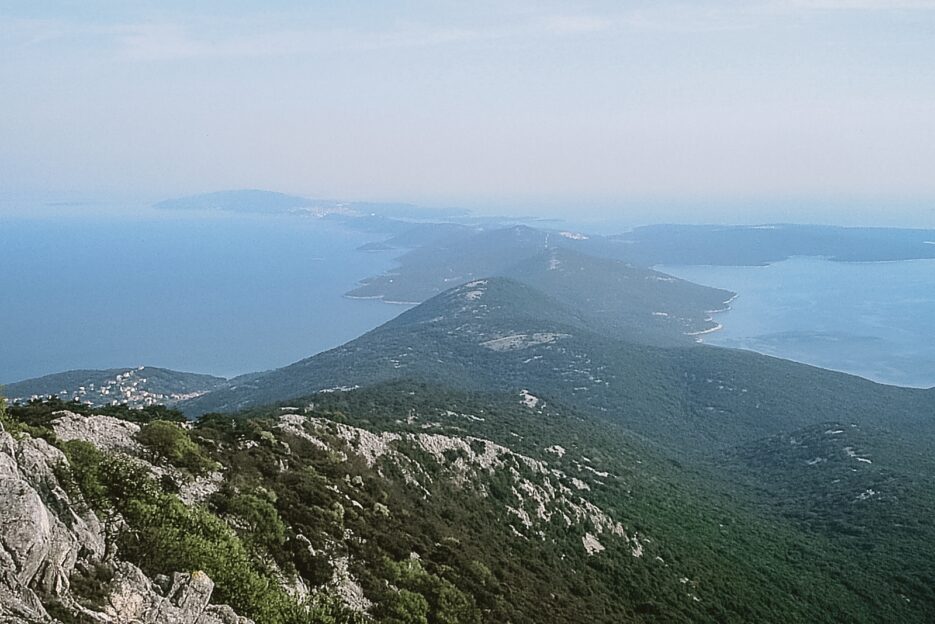
View of Lošinj Island from Osoršcica mountain, Martin Brož, CC BY 3.0, via Wikimedia Commons
Two main hiking trails to Osoršćica start near Osor and Nerezine, on the eastern coast of the island of Lošinj. The trail from Osor leads through the shelter of St. Gaudentius. It was named after the medieval bishop of Osor, who lived as a hermit in a cave under the Televrina peak. According to the legend, he banished poisonous snakes from the Cres-Lošinj archipelago, and anyone who takes a piece of the cave rock is forever protected from the attacks of wild animals. Inhabited by humans in the Stone Age, the Vela Jama cave is another interesting place to see. There is also the Church of St. Nicholas (Sv. Nikola) on Osoršćica Mountain, where local people make pilgrimages every year on July 27
7. Nerezine, a sleepy fishing village.
Nerezine is the first settlement you pass after entering the island of Lošinj. Most tourists are focused on visiting Mali and Veli Lošinj, so they usually don’t stop here. Maybe it is also because the popular travel guides about Croatia barely mention this fishing village.
Nerezine does not stand out with anything special at first glance. It seems just another sleepy fishing village without significant monuments and instagrammable tourist attractions. So why did I mention Nerezine as one of the top 10 things to do in Cres and Lošinj?
One cloudy afternoon we went on a trip to the island of Cres. After leaving the town of Veli Lošinj, where we rented an apartment, we drove towards Osor. Nerezine was the first place we stopped for a while, and honestly, we didn’t expect much from it. However, this quiet village turned out to be a very positive surprise.
Nerezine is just a few streets winding between tiny colorful houses and a small port where boats are lazily rocking. However, I liked the quiet and sleepy atmosphere here. You don’t have to rush anywhere while in Nerezine. Strolling along the waterfront, you can calm down and relax. I also fondly remember the taste of mascarpone and figs ice cream, which we bought at Moby Dick. Be sure to visit this ice cream shop while in Nerezine.
8. Mali Lošinj and the Čikat bay.
Mali Lošinj is the largest island town on the Adriatic and, according to many, one of the most beautiful in northern Croatia. Picturesquely situated in a sheltered cove, it is a very aesthetic place with lovely architecture and lush greenery. One of the best things to see in Mali Lošinj is the Čikat bay, which used to be a luxurious seaside resort of the Viennese aristocracy. A fun fact is that one of the local villas belonged to Emperor Franz Joseph and Sisi.
The center of Mali Lošinj is its port, where sailing yachts, ferries, and boats are constantly arriving. There is a beautiful promenade with numerous cafes, restaurants, and shops. A perfect place to stroll around, especially in the evening. It is also worth getting lost in the labyrinth of narrow streets to feel the atmosphere of Mali Lošinj and find some hidden gems, such as the Fritzi Palace. It houses a rich collection of works by Croatian and European artists. Don’t miss the Apoxyomenos Museum, which is one of the tourist attractions in Mali Lošinj.
Located behind a dense pine forest, Čikat bay has a different atmosphere than the bustling city center. There are historic 19th-century villas built by the former Austro-Hungarian aristocracy and business elite, which house five-star hotels and luxury guesthouses. Don’t miss the pink Villa Karolina with elegant steps on the waterfront. It belonged to Franz Joseph and the famous Empress Sisi. Along the bay is a scenic promenade, where you can admire the views of the sea and the island of Susak.
Mali Lošinj is both a bustling port and a luxurious health resort where you can feel the atmosphere of the former Austro-Hungarian empire. I think it is a perfect place to stay for people who appreciate beautiful nature and secluded beaches but would like to have shops, restaurants, and other tourist attractions nearby. If you want to learn more about the best things to do in Mali Lošinj, do not miss my blog post: Mali Lošinj, the pearl of the Kvarner Bay.
9. Veli Lošinj, a small town with an Italian vibe.
In Croatian, veli means big, and mali means small. Despite its name, the town of Veli Lošinj is much cozier than Mali Lošinj. The location in a long and narrow bay, which at first was an advantage, later became an obstacle to the further development of the port. At that time, the neighboring Mali Lošinj gained importance and became one of the largest maritime trading centers in the Adriatic. Veli Lošinj, on the other hand, remained a lovely town with baroque tenement houses and winding streets.
I heard that many people who visit Veli Lošinj for the first time are surprised by the size of the port. Although it looks more extensive in the photos, a walk along the waterfront takes only a few minutes. The town of Veli Lošinj has an Italian feel and reminds me a bit of Portofino. It’s best to visit one of the seaside cafes, order an espresso and contemplate the atmosphere of this place.
I think most tourists visit only the center of Veli Lošinj. They usually walk around the port, looking at the colorful baroque tenement houses and the Church of St. Anthony Abbot (Crkva Sv. Antuna Abbot). Some also visit the Maritime Education Center and the Tower – Museum of Veli Lošinj, on top of which there is a small observation deck. Meanwhile, Veli Lošinj consists of three parts: the aforementioned representative port, the quiet fishing bay of Rovenska, and the upper settlement, which has a more rural feel.
Apart from the port and the old town, Veli Lošinj has many beautiful hiking trails. Some paths lead through olive groves to small pebble beaches and hidden coves. Walking or cycling along the coastal Path of Vitality that leads to the town of Mali Lošinj is also a fun thing to do. Don’t forget to go to the hill of St. John (Sv. Ivan) above the town to capture a beautiful panorama of Veli Lošinj. The top can be reached on foot or by car via a gravel road from Mali Lošinj. Along the way, you can visit the famous bar at the Providenca viewpoint. It is probably the most instagrammable place on the island of Lošinj.
Veli Lošinj was the place where we stayed for a few days during our visit to the islands of Cres and Lošinj. Thanks to this, I had the opportunity to feel the atmosphere of this beautiful town and discover its hidden gems. If you want to learn about the best things to do in Veli Lošinj and the most beautiful beaches, check out my blog post: Veli Lošinj, Croatia – a beautiful small town in Lošinj Island.
10. The Cres-Lošinj archipelago.
The Cres-Lošinj archipelago consists of Cres, Lošinj, and 34 smaller islands, of which only five are inhabited: Susak, Unije, Ilovik, Male Srakane, and Vele Srakane. During my short spring trip, I visited the beautiful island of Susak. If you want to read about this place and see some photos, check out my blog post: Susak, a Croatian island with sandy beaches.
The small islands of the Cres-Lošinj archipelago are the icing on the cake for those looking for hidden gems and off-the-beaten-path places. Although quite distant from each other, they are accessible by public transport. However, passenger ferries rarely run, and if you want to go on a day trip to Susak or Unije on weekdays, you have to get up at dawn. For those who are not early risers, I recommend visiting the island of Ilovik, which is reachable by water taxi.
What are the most beautiful beaches on Cres and Lošinj?
The islands of Cres and Lošinj are full of beautiful beaches and hidden coves where you can take a break from the hustle and bustle and enjoy the beauty of nature. Some of them, especially on the steep and mountainous Cres Island, are only accessible from the sea. However, many secret beaches can also be reached by land. It often requires you to wade through narrow maquis paths or descend a steep trail, but the secluded coves are worth it.
I must admit that choosing just a few of the most beautiful beaches on the island of Cres or Lošinj was quite a difficult task for me. It is obvious that some people like long and wide city beaches with sunbeds and bars, while others prefer small scenic bays. For me, secluded coves and secret beaches are the most beautiful, but I respect that different people have different opinions. I hope that regardless of your preferences, everyone will find something for themselves in the list of the best beaches on Cres and Lošinj.
Top 5 beaches on Cres Island
1. Sveti Ivan beach, Lubenice.
Visiting Sveti Ivan beach in Lubenice is one of the top attractions on the island of Cres. It is located at the foot of a 378 m high cliff and is considered one of the most beautiful beaches in Croatia. You can get to the cove in about 40 minutes by going down a steep trail, so many people prefer to reach Sveti Ivan beach by boat.
2. Plava Grota, Lubenice.
If you go on a boat trip to Sveti Ivan beach, do not miss the Blue Grotto (Plava Grota) in the bay of Žanje. In the afternoon, the sun shining through the rock hole illuminates the sea, making it a beautiful blue color. The cave is about 20 meters long and has a small pebble beach inside.
3. Mali Bok beach, Orlec.
Located near the village of Orlec, Mali Bok beach is a true gem of Cres Island. Squeezed between high rocks, the cove offers beautiful views and a crystal-clear turquoise sea. The descent is quite steep, but getting to the beach is not too difficult.
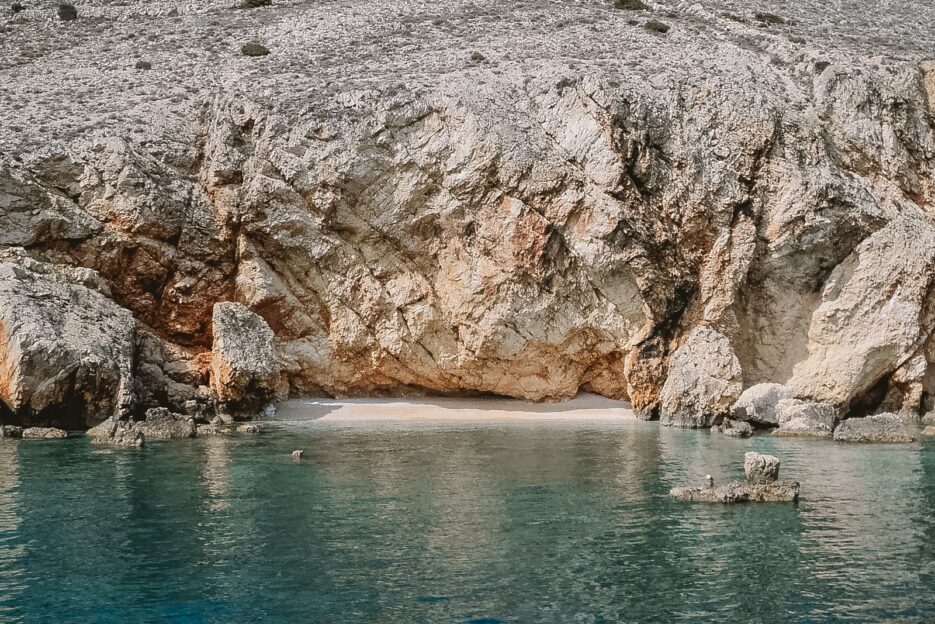
Small secluded beach in Koromačna bay, MEETCROATIA_NET, CC BY 3.0, via Wikimedia Commons
4. Koromačna bay, Belej.
One of the best places to visit on the island of Cres is Koromačna bay, located near the village of Belej. You can relax on the main beach or try to reach one of the small bays hidden under the cliff. Sea caves and the beautiful color of the water make this place truly special. I advise you to take a snorkeling mask when going to Koromačna beach. You won’t regret it.
5. Veli Žal beach, Ustrine.
Veli Žal in Ustrine is considered one of the most beautiful beaches on Cres. In the past, it was possible to reach it by car, but now the access is blocked by a barrier, and the only option to get to the bay is a walk downhill, which takes about 20 minutes. The beach is a lovely place to swim, with fine pebbles and the nice color of the sea. I am sure that some of you will appreciate that there are showers with fresh water on Veli Žal to rinse off the salt. If you are looking for a quiet place just for yourself, it is worth exploring some small coves in this area.
Top 5 beaches on Lošinj Island
1. Veli Žal beach, Mali Lošinj.
Veli Žal is considered the most beautiful beach on the island of Lošinj. Located near a large hotel, it is easily accessible and might be crowded in the high season. Sun loungers, showers, and other facilities are available on the beach. Due to the fine gravel and gentle descent to the sea, Veli Žal seems to be a good place for families with small children. This beach is also an excellent option for tourists who like to have bars, restaurants, and other attractions within their reach.
2. Čikat bay, Mali Lošinj.
Surrounded by luxury hotels and historic villas, Čikat bay is the most popular bathing spot on the island of Lošinj. There are three beaches and a designated swimming area with bars, trendy restaurants, and many entertainment activities such as mini golf, tennis courts, volleyball, basketball, and football courts. You can take windsurfing and diving lessons in Čikat bay, as well as rent a boat, pedalo, kayak, or catamaran.
3. Zabodarski beach, Ćunski.
Zabodarski beach, located near Mali Lošinj Airport, is one of the most beautiful bays on Lošinj Island. I consider this place an excellent alternative for people who don’t like crowded bathing areas like Čikat bay or Veli Žal beach. Due to the relatively shallow descent to the sea and the pine forest that provides a pleasant shade, the beach will also be suitable for families with small children. There are several smaller coves near Zabodarski beach for those looking for secluded places.
4. Bijela beach, Ćunski.
Located near Mali Lošinj Airport and the village of Ćunski, Bijela beach is a wild part of the coast. Due to the beautiful azure color of the sea, this place has become a popular destination for boat trips. You can also get here on foot, but the trail might be challenging and tiring. The walk to Bileja beach takes about 45 minutes along stony and sandy forest roads, so it is worth putting on good shoes. My advice is also to give up unnecessary beach bags and other accessories.
5. Plieski beach, Veli Lošinj.
Plieski is another secluded cove on the island of Lošinj that might appeal to keen hikers. It takes some effort to get here, but the beautiful pebble beaches and turquoise sea are worth it.
How to get to Cres and Lošinj?
The easiest way to get to Cres and Lošinj is by car ferries from Istria or the island of Krk. The ferry crossing time from Brestova (Istria) to Porozina is about 20 minutes, and from Valbiska (Krk) to Merag is about 25 minutes. Current ferry schedules and ticket prices are available on the Jadrolinija website.
People who travel without a car can also get to Cres and Lošinj by passenger ferries departing from Rijeka, Pula, Rovinj, and other cities. You can find more details on how to get to Cres and Lošinj in my blog post: Mali Lošinj, Croatia – the pearl of the Kvarner Bay.
Where to stay on Cres and Lošinj?
What is the best place to stay on Cres and Lošinj? It’s hard for me to answer because it depends on individual preferences. If you would like to rent an apartment in a lively place with a promenade, old town, shops, and other attractions, the cities of Mali Lošinj and Cres would be the best choice. For those who prefer small, atmospheric towns, I would recommend Veli Lošinj on the island of Lošinj (we stayed in this apartment) or Osor. Located at the junction of two islands, it is a good base for exploring both Cres and Lošinj.
If nice beaches and a quiet location are more important to you than proximity to the city, Nerezine on the island of Lošinj, Martinšćica, or Valun on the island of Cres may be a good choice. Martinšćica and Valun have lovely secluded coves nearby that can be reached by kayak or boat. Some settlements on Cres Island feel like the end of the world. If you like such vibes, you can stay in Beli, Orlec, or Ustrine. There are also several campsites on the islands: Camping Čikat in Mali Lošinj, Camping Kovačine in Cres, Camping Bijar in Osor, Slatina in Martinšćica and Zdovica in Valun. You can check the accommodation prices on the map above.
Is it worth visiting Cres and Lošinj? Which island is a better place to stay?
There are different opinions about Cres and Lošinj. Some like it here, while others compare the islands to the Dalmatian coast and feel unsatisfied. It all depends on your expectations and attitude. People who have only been to the southern part of Croatia so far and expect similar experiences may be a bit disappointed. However, Cres and Lošinj might be appreciated by those looking for a quieter alternative to the Istrian peninsula, with secluded beaches and a peaceful atmosphere.
I must say that I had a great time in Veli Lošinj. Perhaps this little town was not as spectacular as Rovinj in Istria, which we visited a year earlier, but it was beautiful and full of atmosphere. The proximity to secluded coves was also a great advantage. We were often the only ones on the beach, and I think it would be hard to find such quiet places on the west coast of Istria. When the weather was not so good to lay on the beach, or when we needed to do some shopping, we used to go on a trip to Mali Lošinj. The city was just a stone’s throw from Veli Lošinj and offered some more tourist attractions and things to do.
Speaking of Mali Lošinj, the historical villas of the Austro-Hungarian aristocracy in Čikat bay are must-see. There are also five-star hotels and fine restaurants along the waterfront. The white stone tiles on the promenade create a nice contrast with the turquoise color of the sea, and the lush vegetation provides a pleasant shade. For me, Čikat bay is an attractive combination of Viennese splendor and elegance with the peaceful atmosphere of the Croatian island. It’s a luxurious spa resort with the vibe of the former Austro-Hungarian Empire.
When I think about the island of Lošinj, I see port towns, colorful houses, tall palm trees, green pine forests, and a white marble promenade in Čikat bay. Cres Island has a different vibe. Just try to imagine the harsh landscape and hills where flocks of sheep graze, beautiful beaches hidden under cliffs, and stone villages perched on rocks. One of the most charming places I visited on Cres was Osor, probably the most Dalmatian-looking town on the island. I also liked the vibrant capital city of Cres, which on the other hand, had an Italian feel.
Compared to the island of Lošinj, the coastline of Cres is wild and less accessible, but in my opinion, it offers more beautiful beaches. Secluded coves hidden under the cliffs are a real treat if you are looking for some tranquility. The finest beaches on Cres are often hard to reach, so it’s better to be prepared for a longer hike. An alternative option is to get there by boat or sea kayak. This island is a true paradise for trekking and paddling enthusiasts.
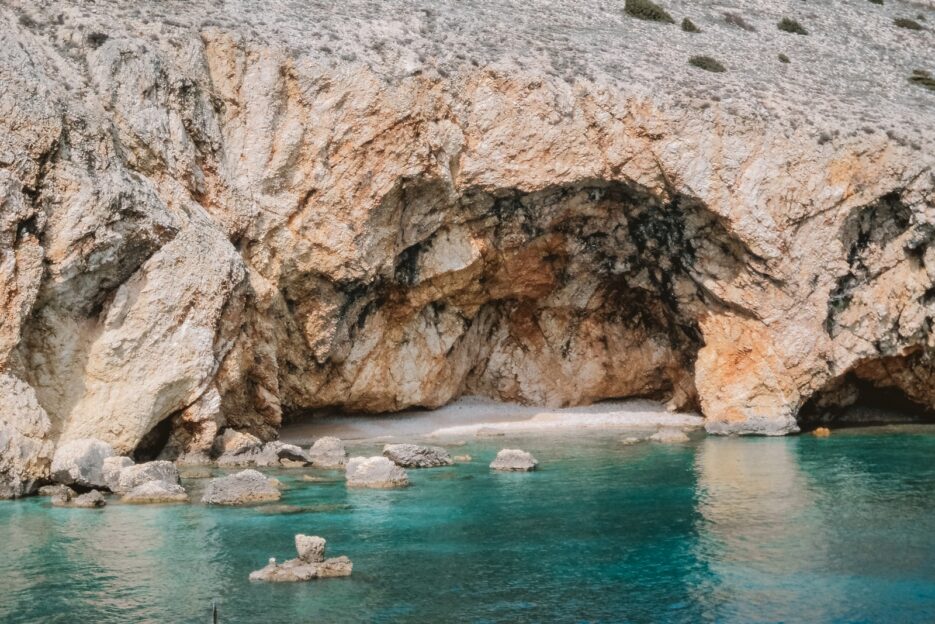
A beautiful beach in Koromačna bay, MEETCROATIA_NET, CC BY 3.0, via Wikimedia Commons
The vegetation on the islands is also different. Leaving the ferry in Porozina and driving along Cres, I first saw dense deciduous and mixed forests. The further south I moved, the sparser the vegetation became. Oaks and chestnut trees were replaced with stone slopes covered with maquis and olive groves.
After crossing the bridge in Osor, which connects the islands, the landscape changed again. The road on the island of Cres leads along a steep ridge, and on the island of Lošinj, it winds along the coast. The farther into the island, the more exotic the vegetation. In Mali and Veli Lošinj, I saw old palm trees, colorful flowers, and various plants that the captains brought from their overseas expeditions. There are also pine forests, fragrant herbs, and olive groves.
Is it better to visit Cres or Lošinj? Well, it’s hard to say because I find both islands very beautiful and worth visiting. If you like the atmosphere of a seaside resort and walking around pretty port towns sounds attractive, I suggest staying on Lošinj Island. Cres Island, on the other hand, will be a better choice if you like hiking in nature and exploring secluded beaches. I also recommend this island to people who have a boat or kayak. If I were to choose, I would go to Lošinj in the early spring, and during the hot summer months, perhaps I would stay in a quiet village on Cres with secret beaches that I could reach on my sea kayak.
If you are looking for beautiful seaside towns and secret beaches in northern Croatia, I recommend visiting Cres and Lošinj. They might be an alternative to the more developed coast of the Istrian peninsula or other islands in Kvarner Bay, such as Krk, Rab, and Pag. There are a lot of tourist attractions and things to do in Cres and Lošij. You can stroll around the old towns, visit museums, go shopping, or relax in quiet villages and secluded coves. If you ask me whether it is worth visiting Cres and Lošinj, I would highly recommend it. A trip to these islands was a great idea, and I would love to go back there one day.
Do you like this post? Pin it!

